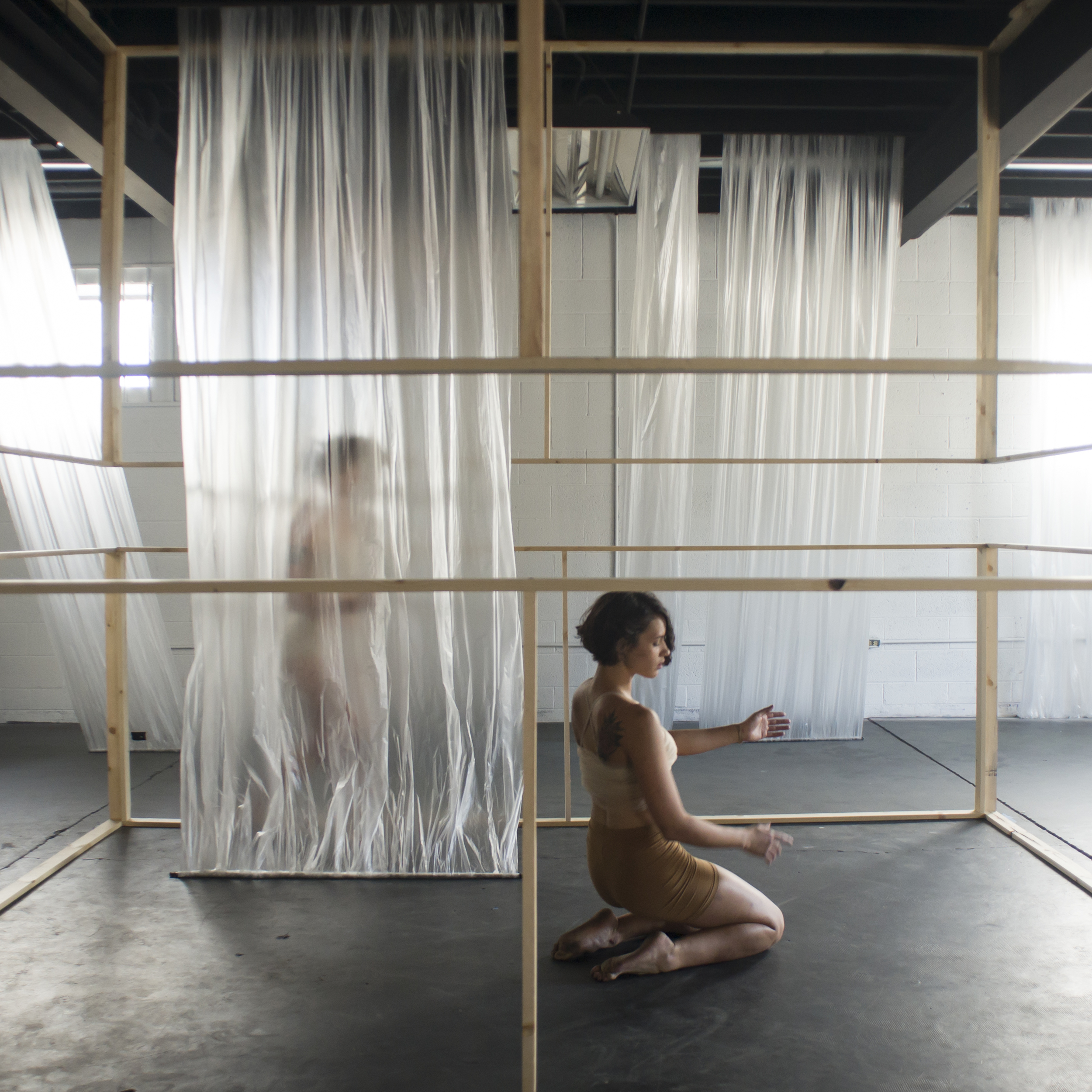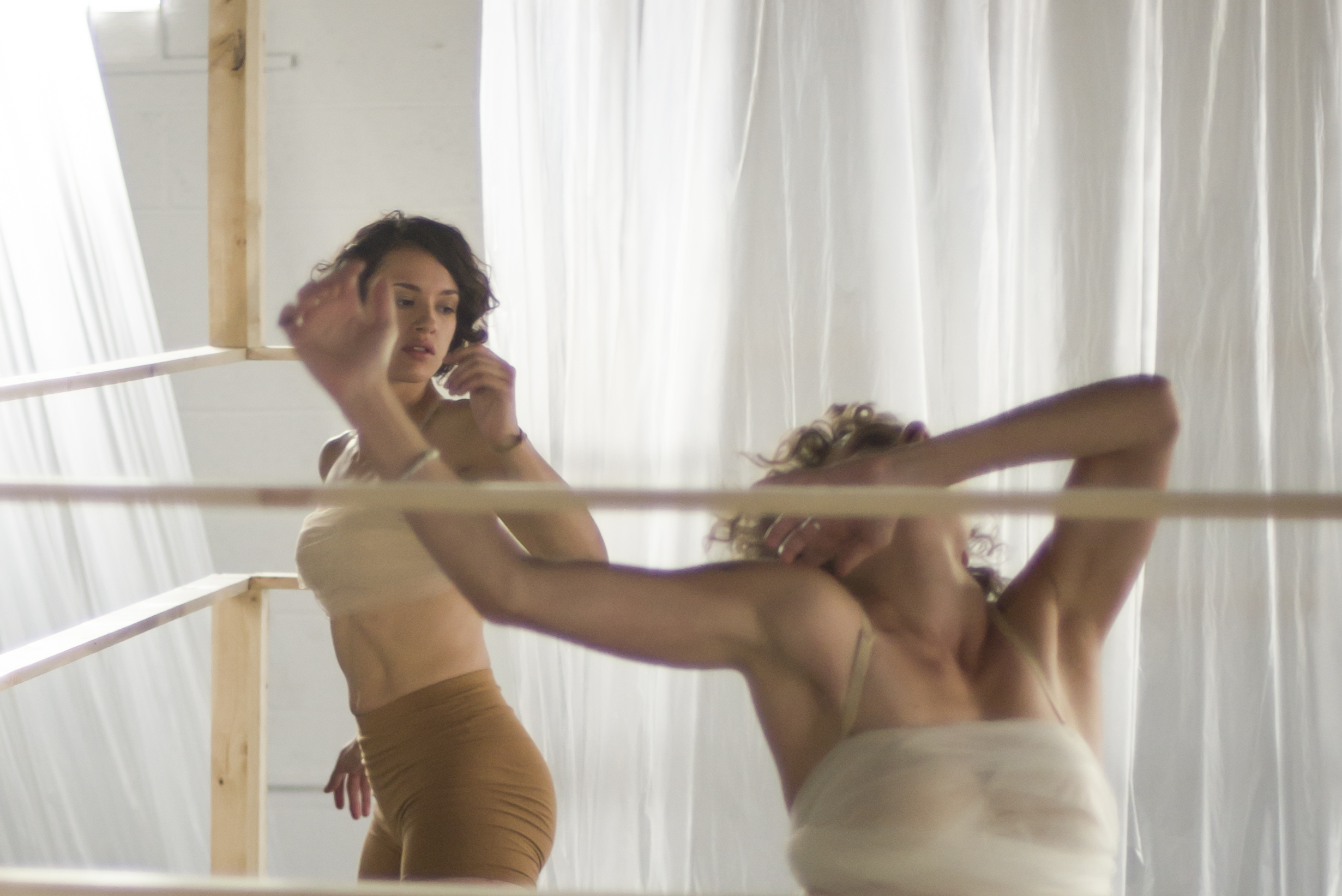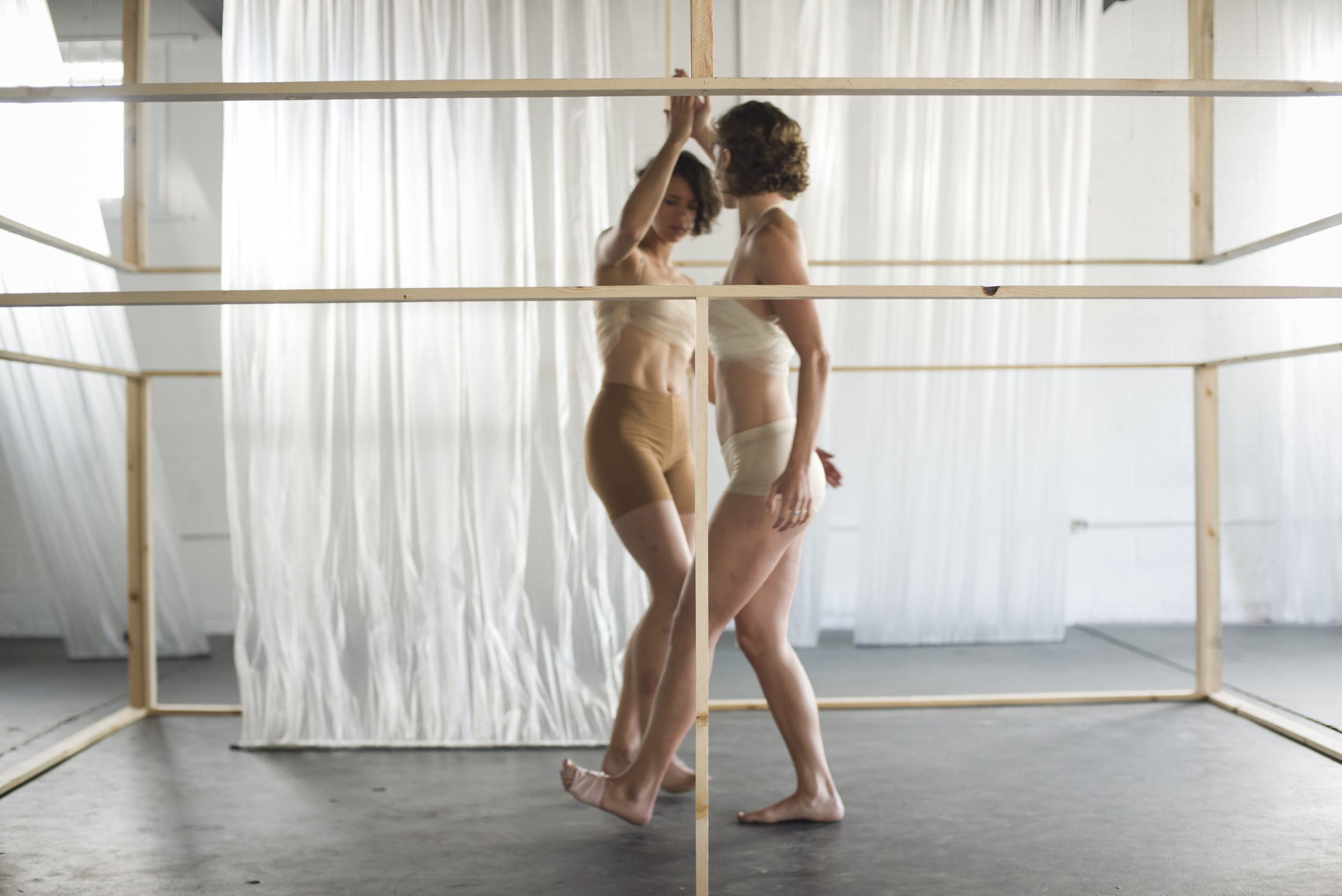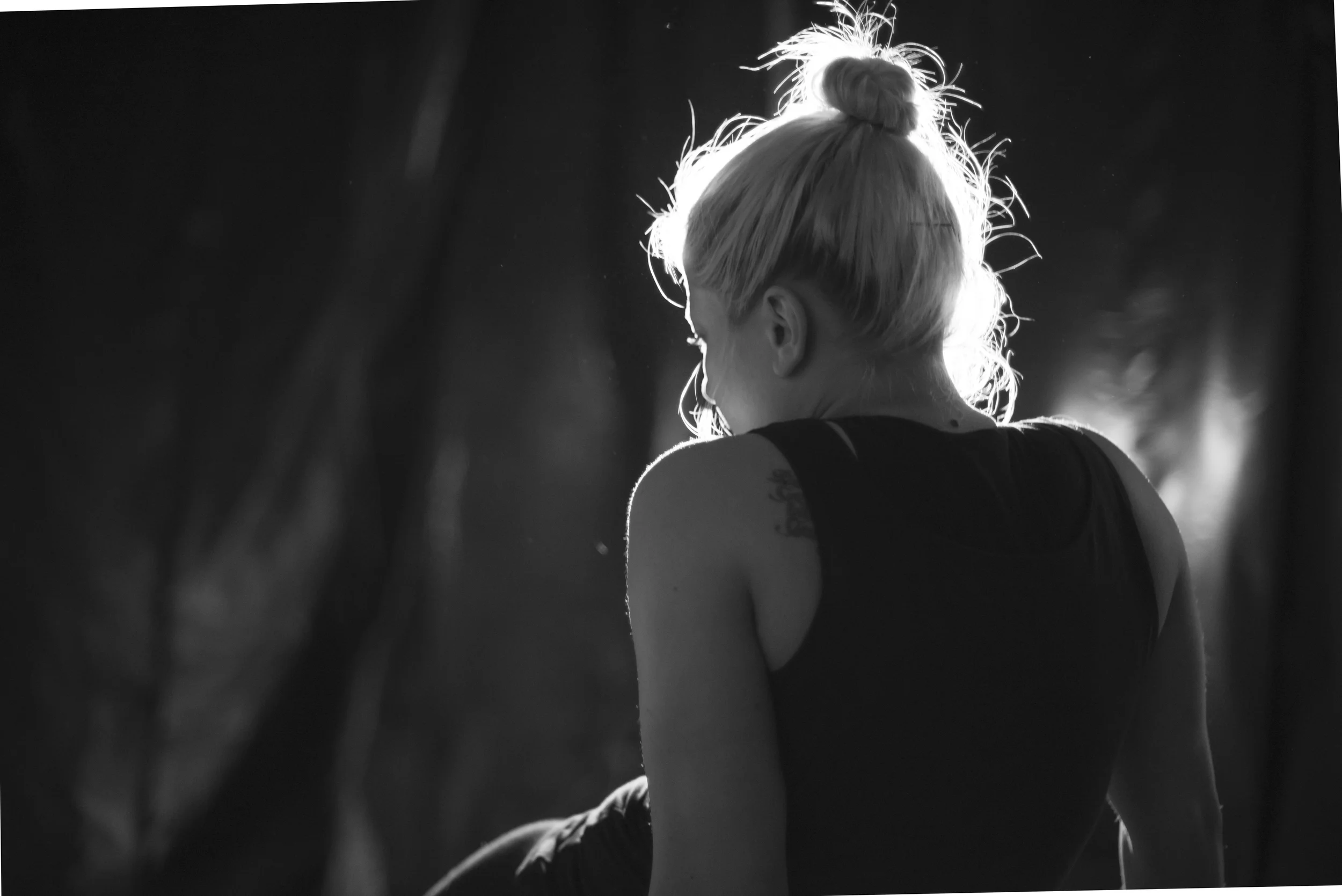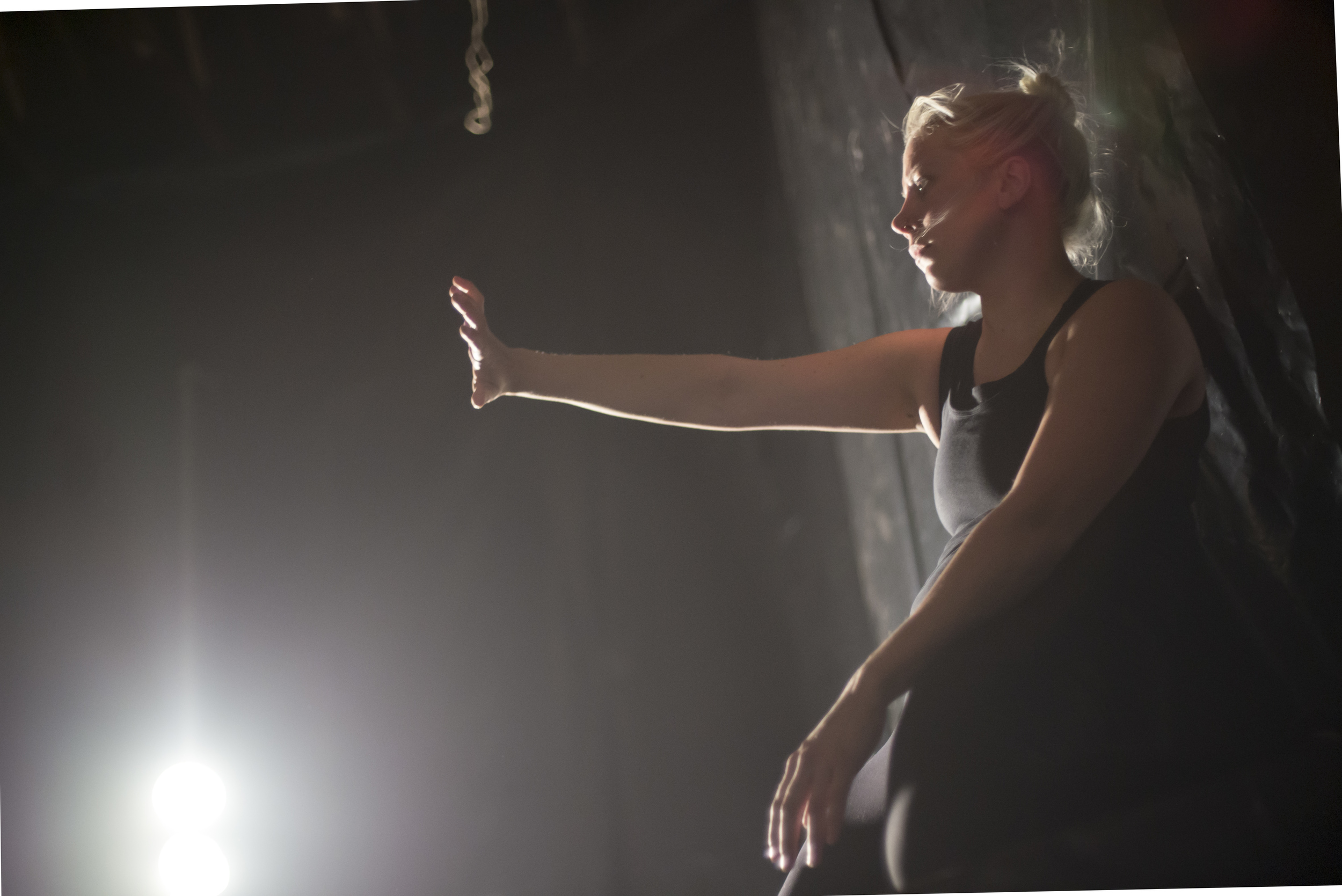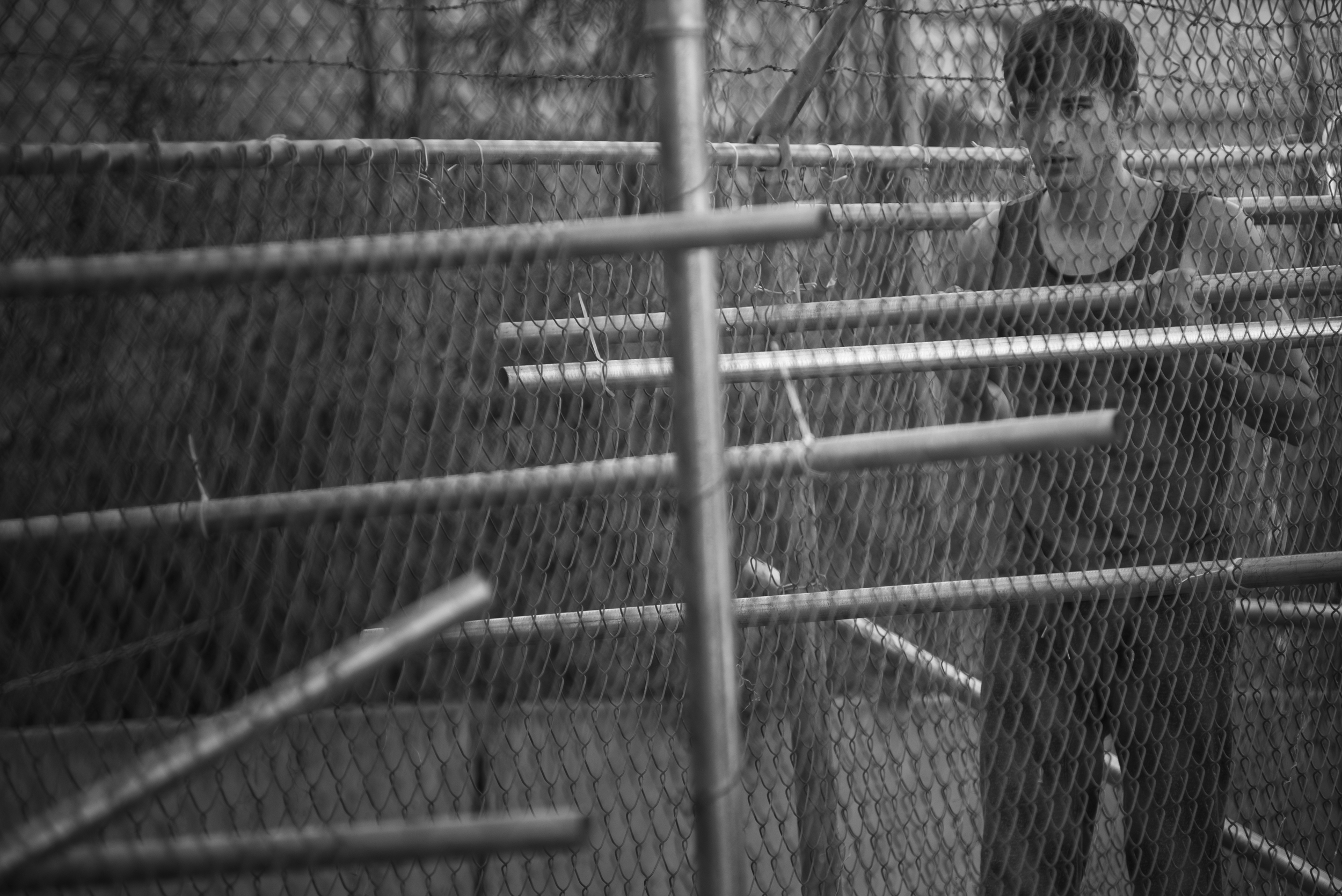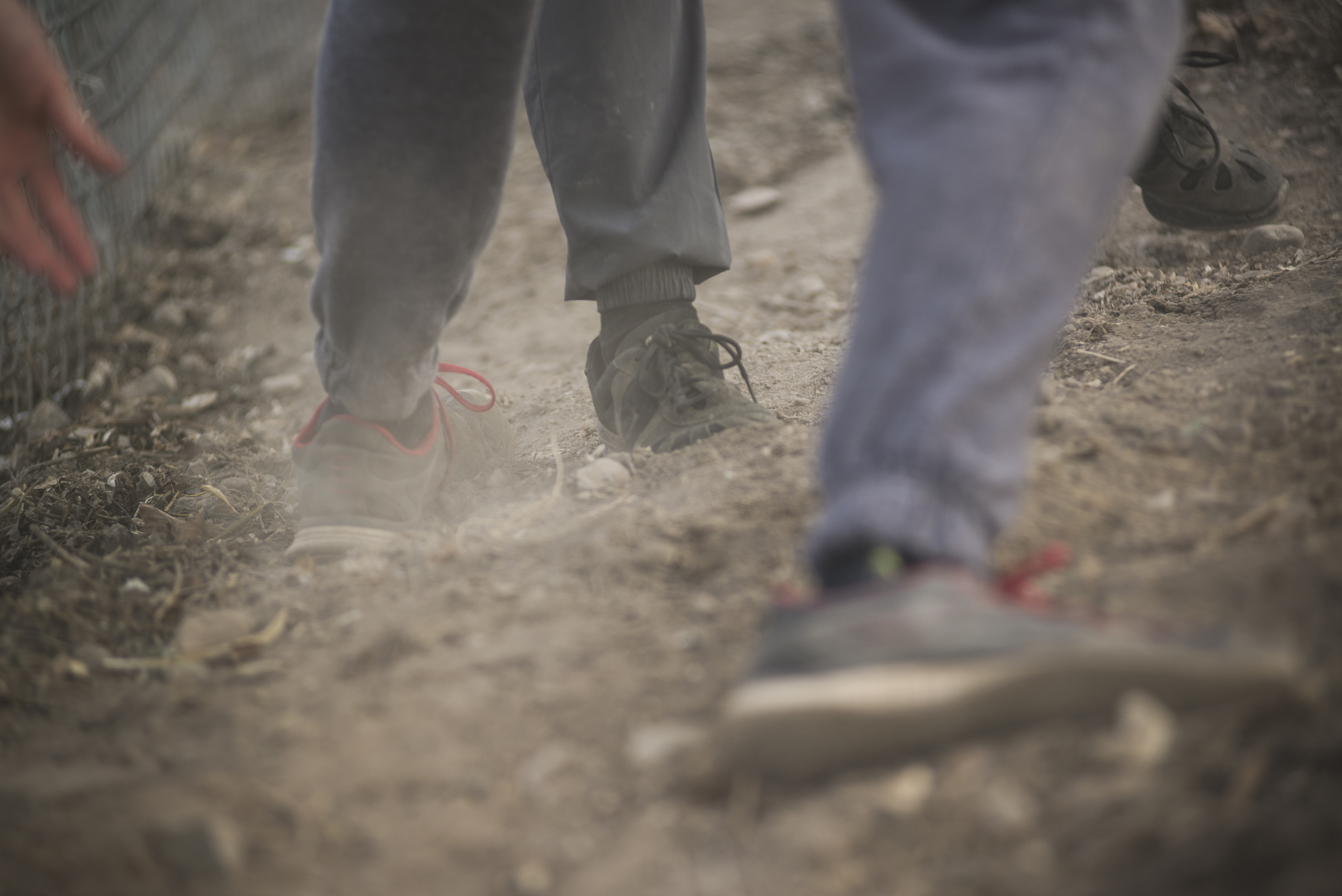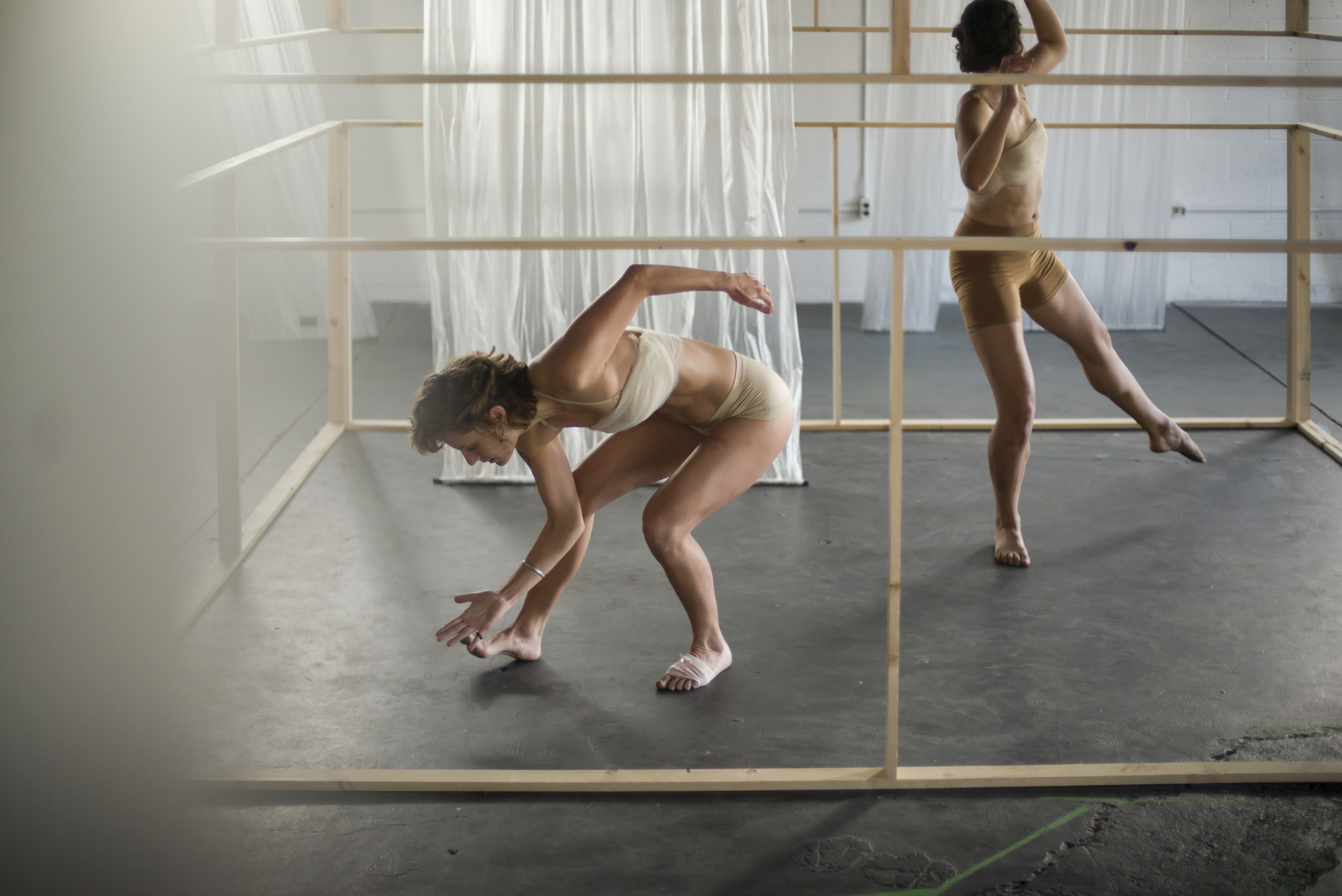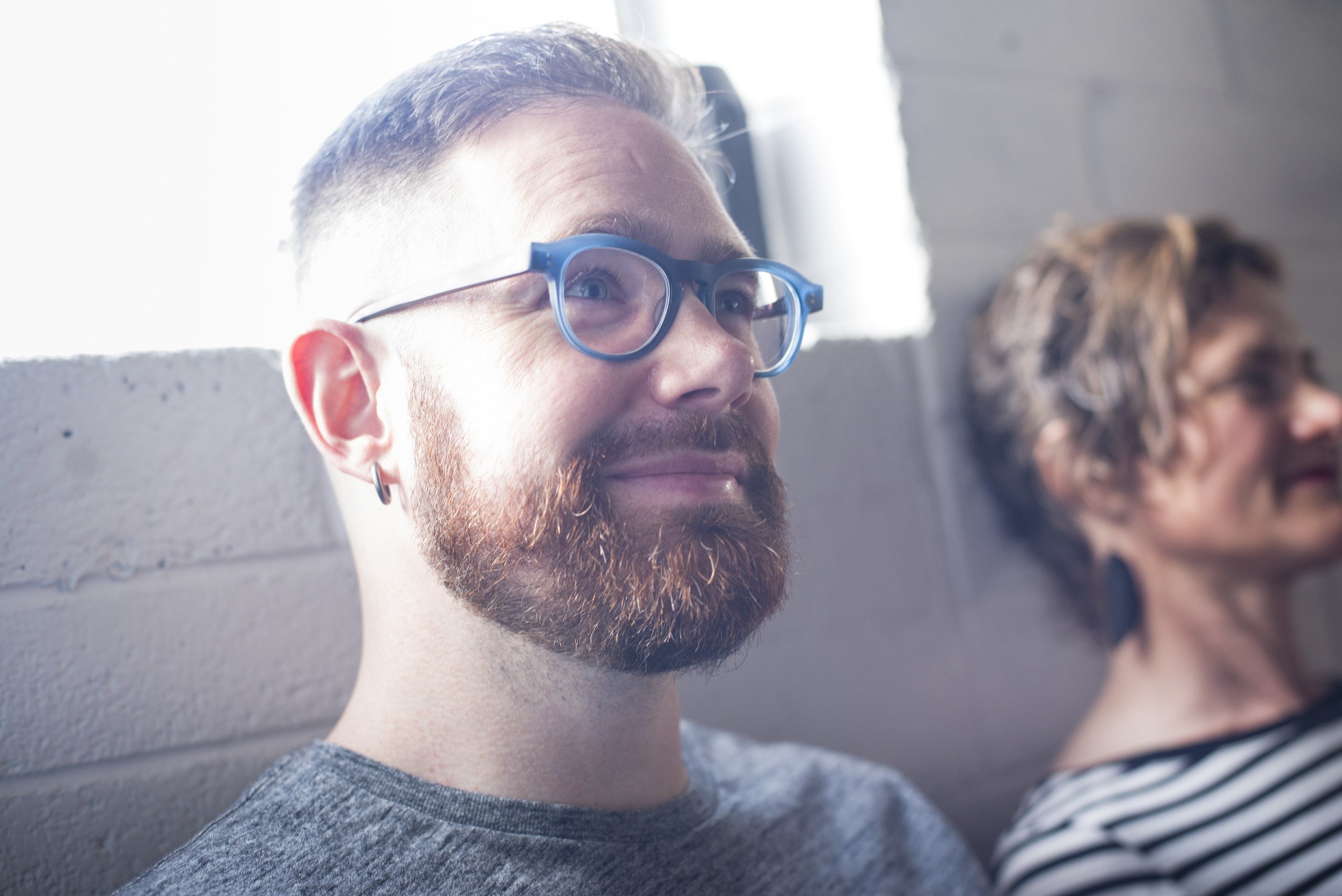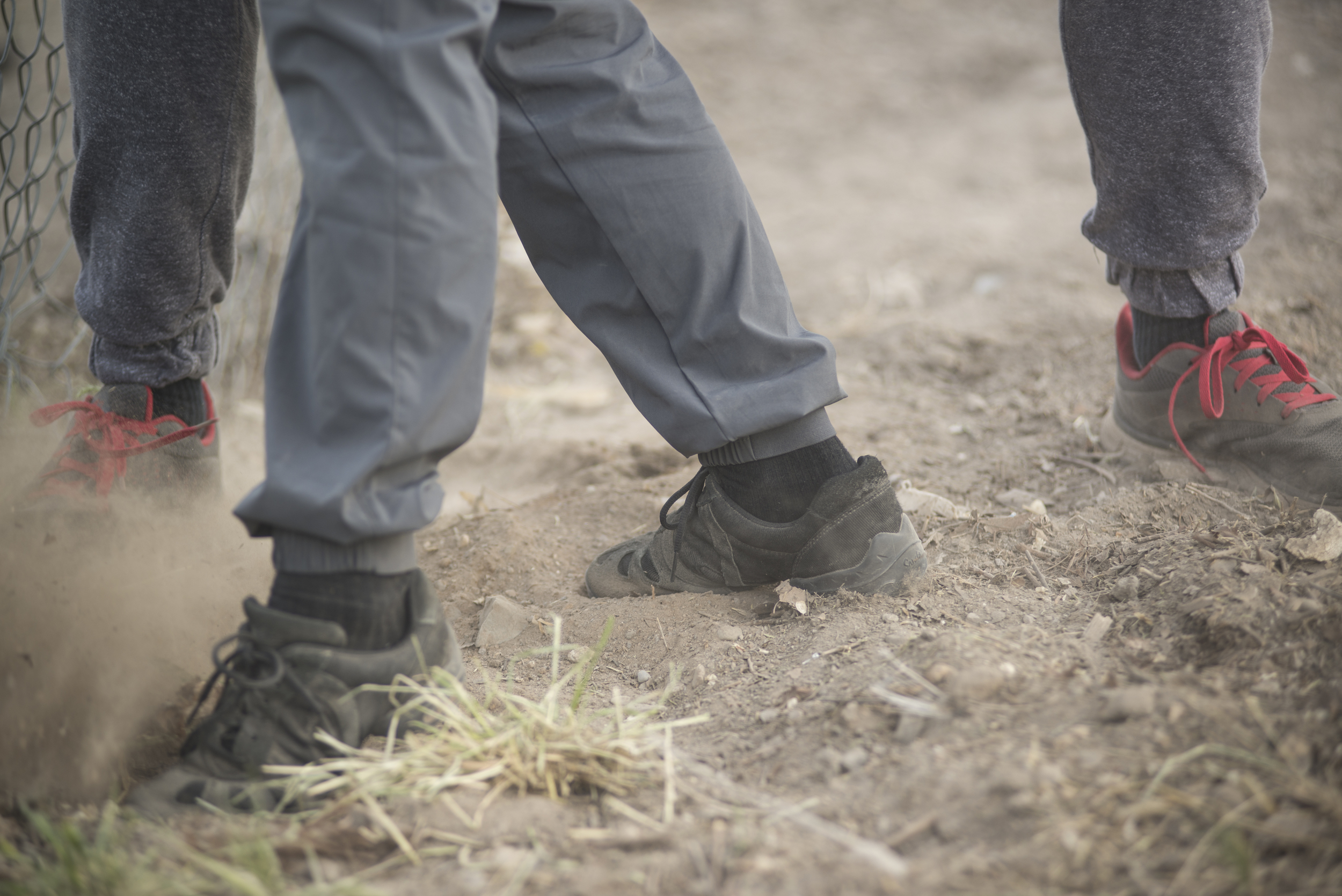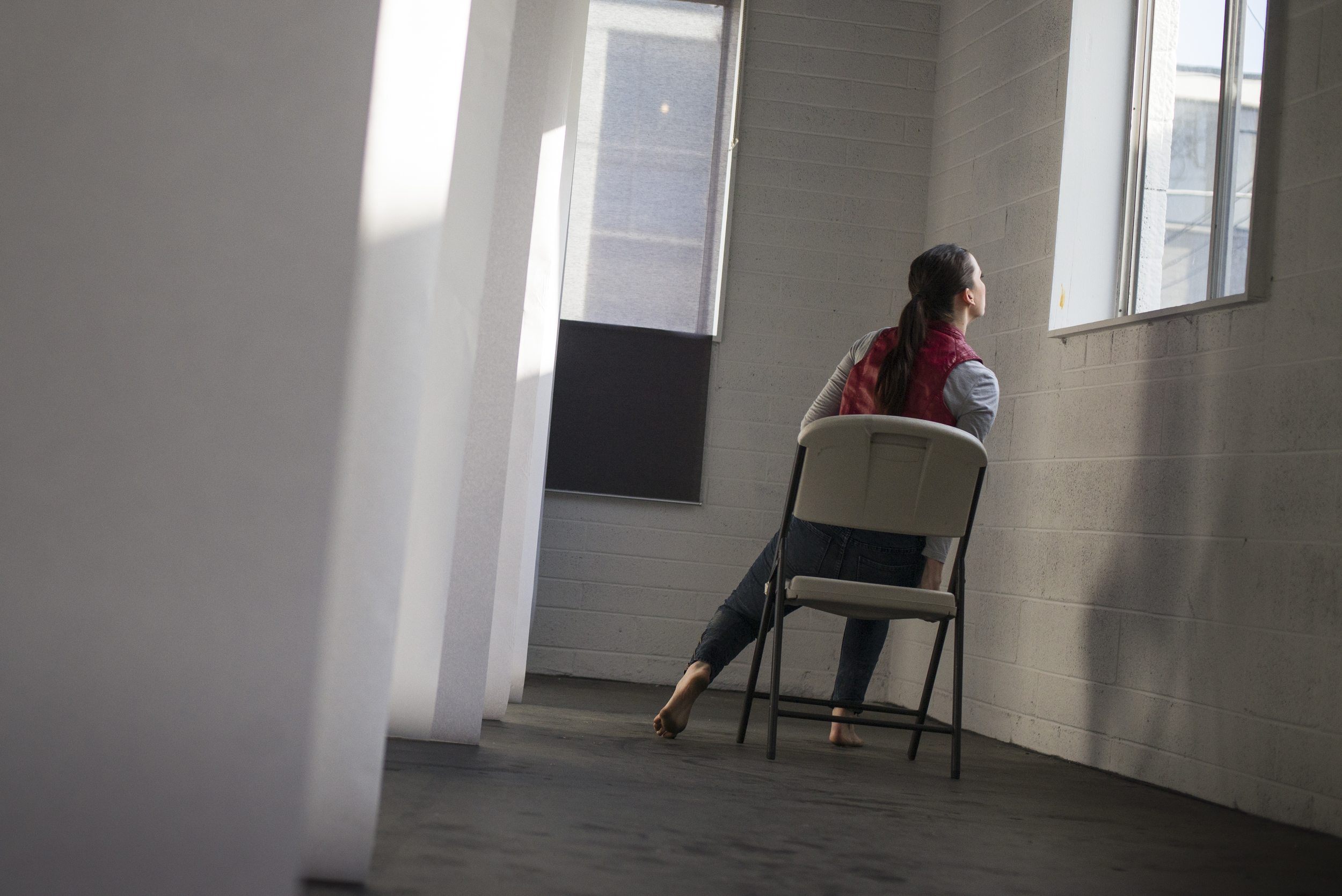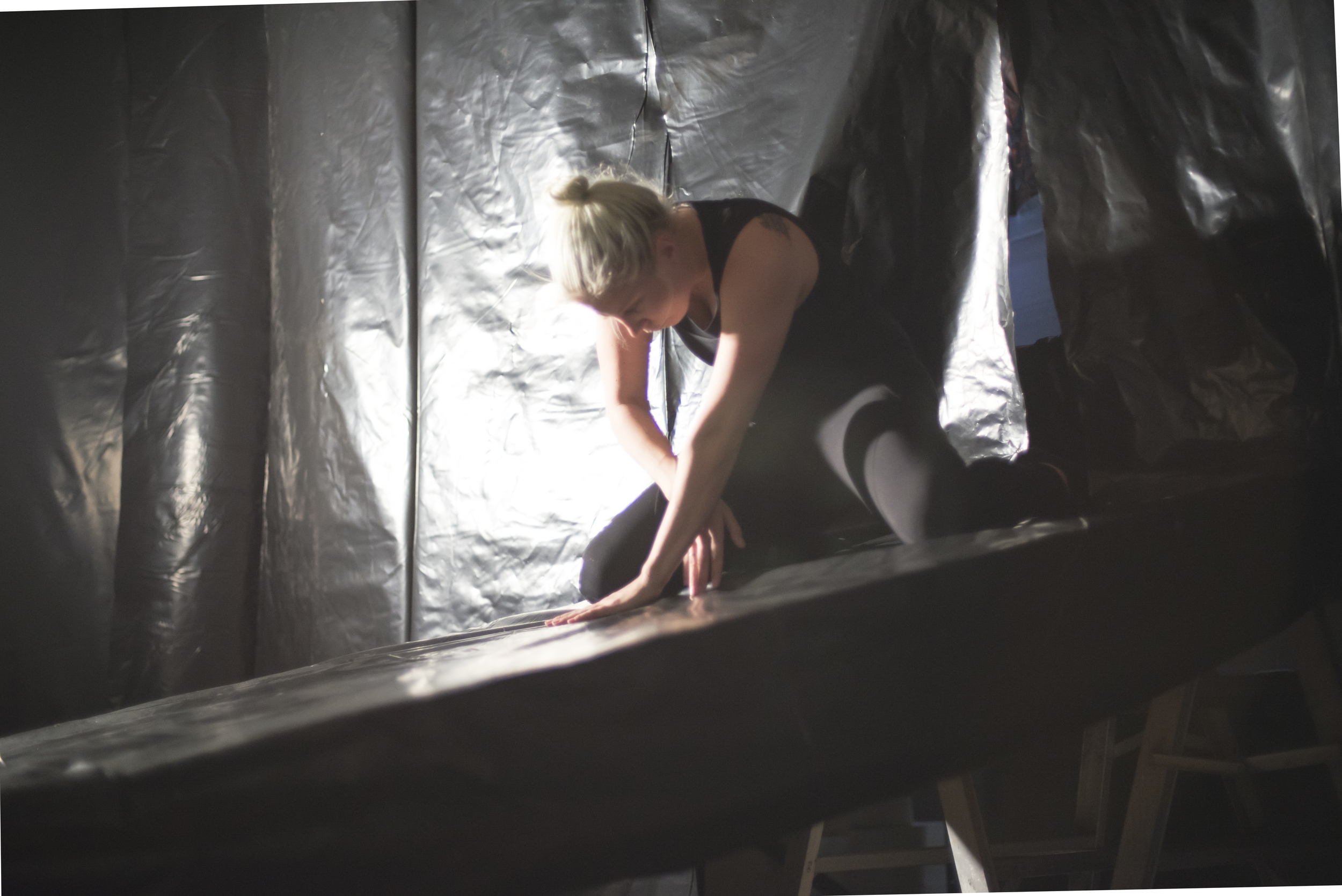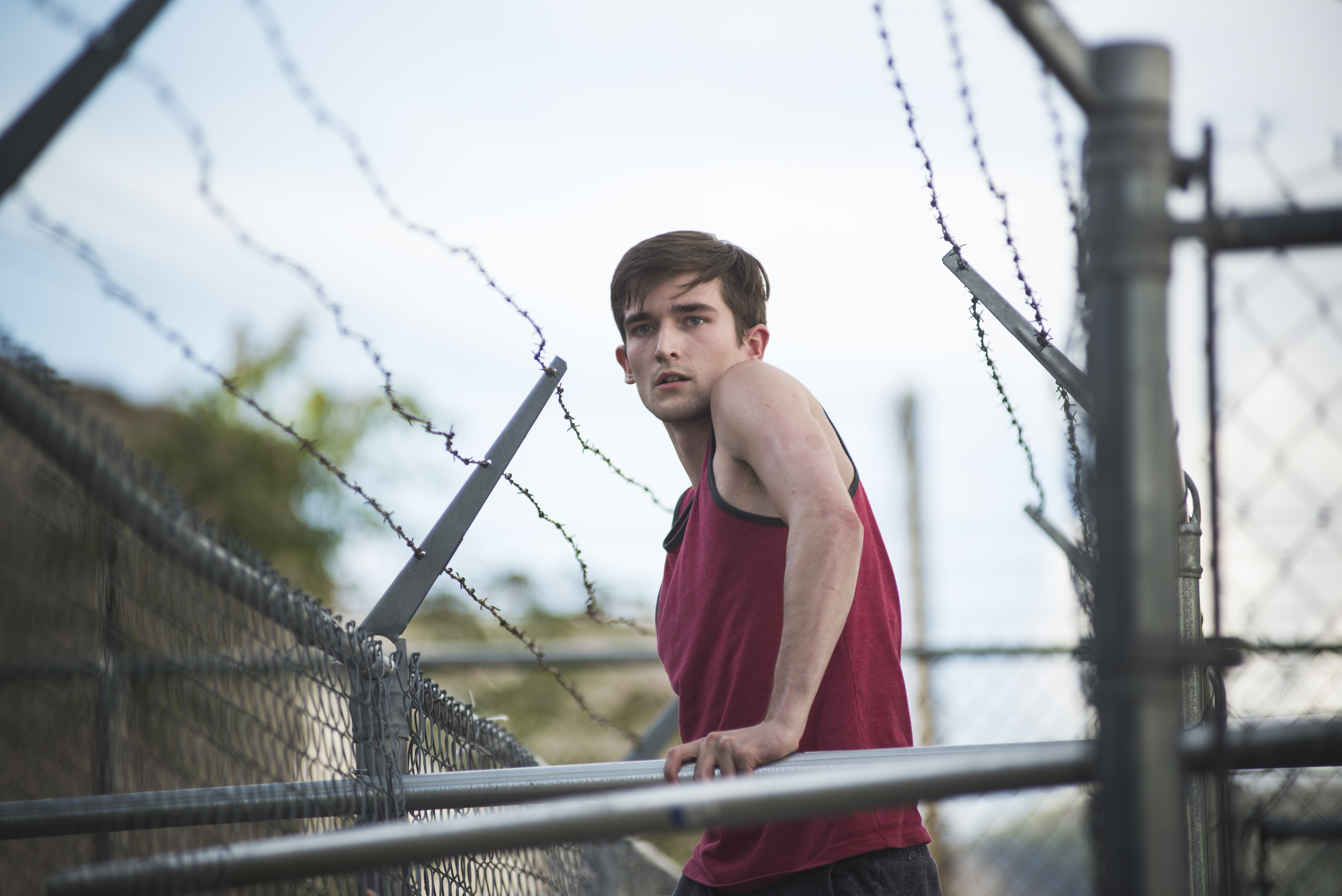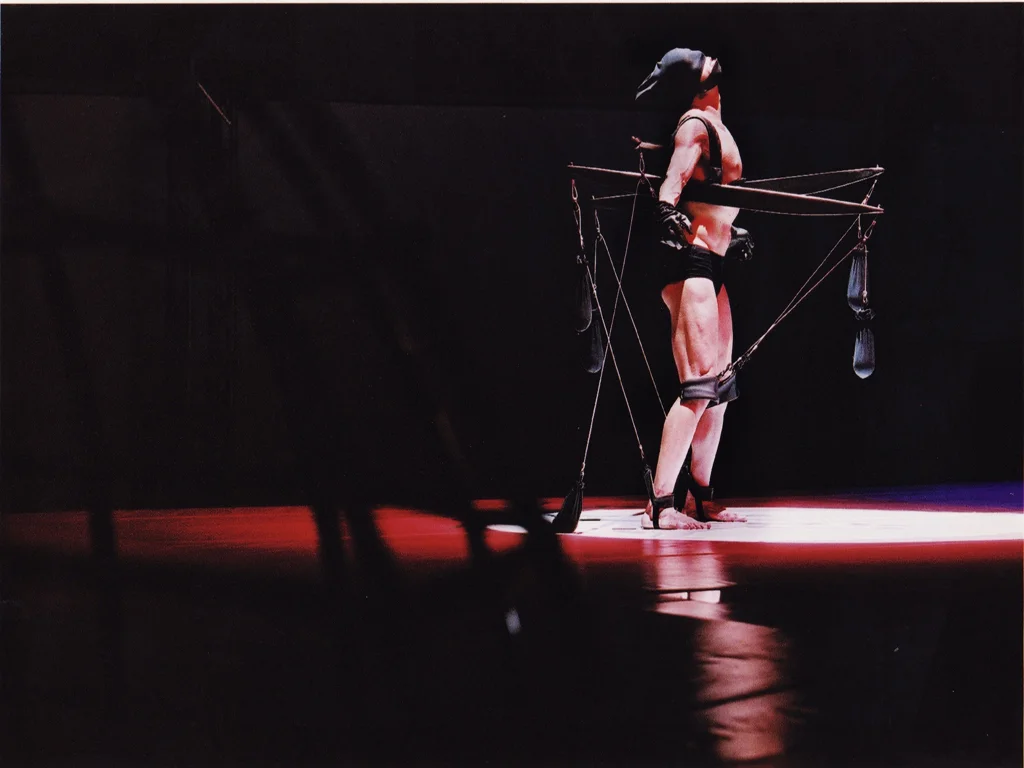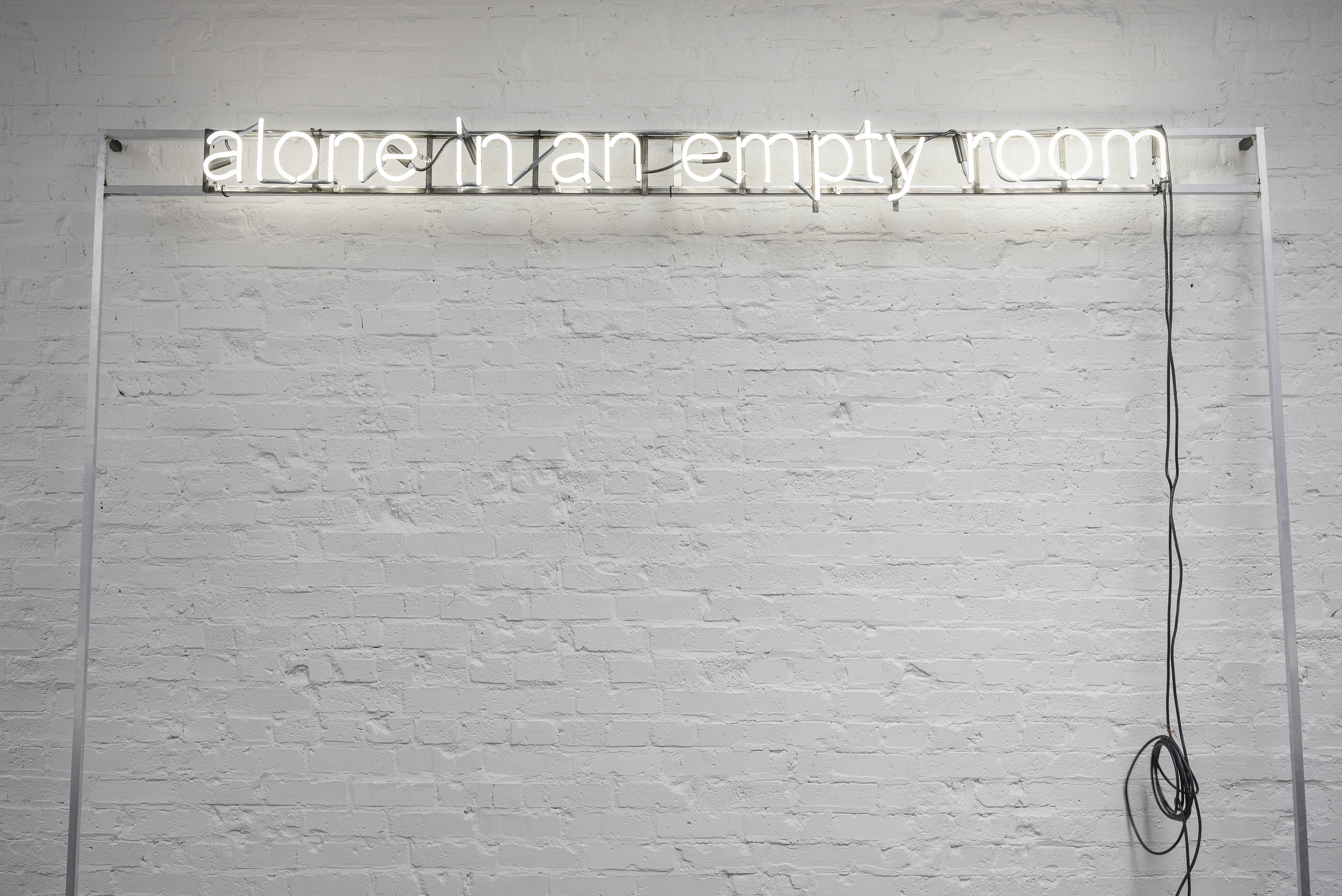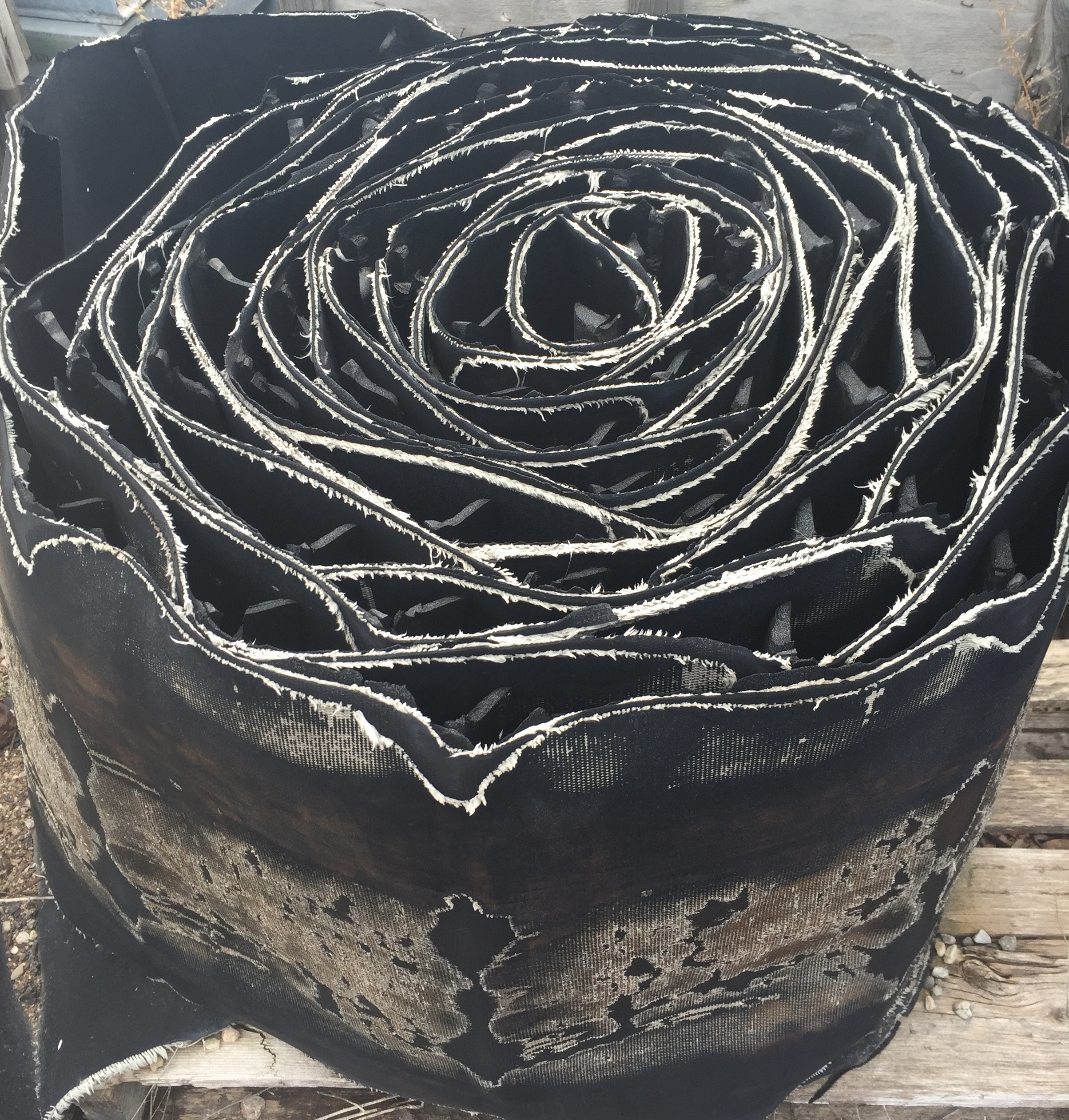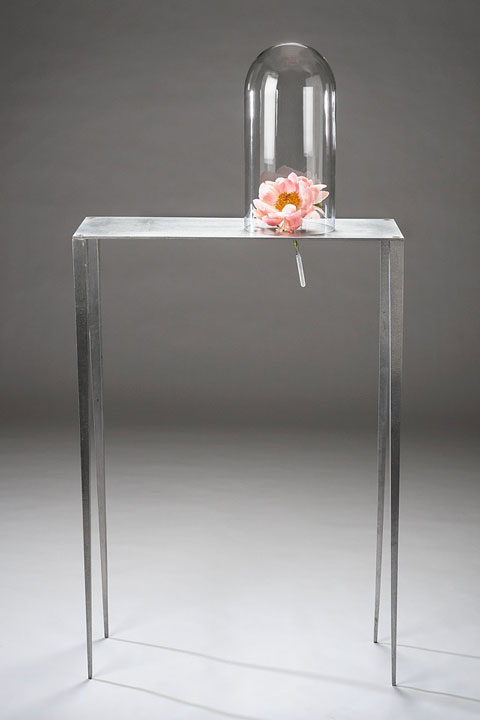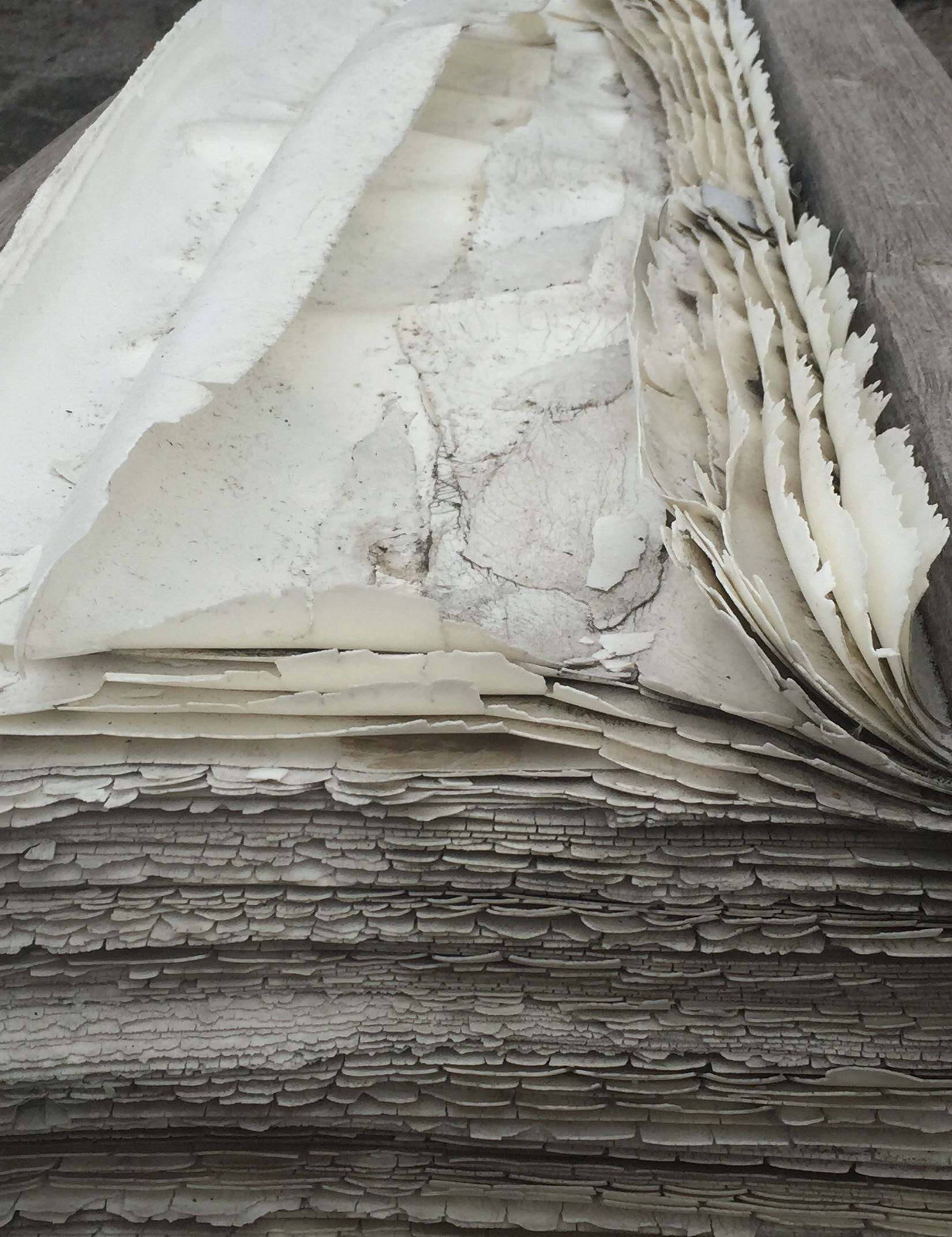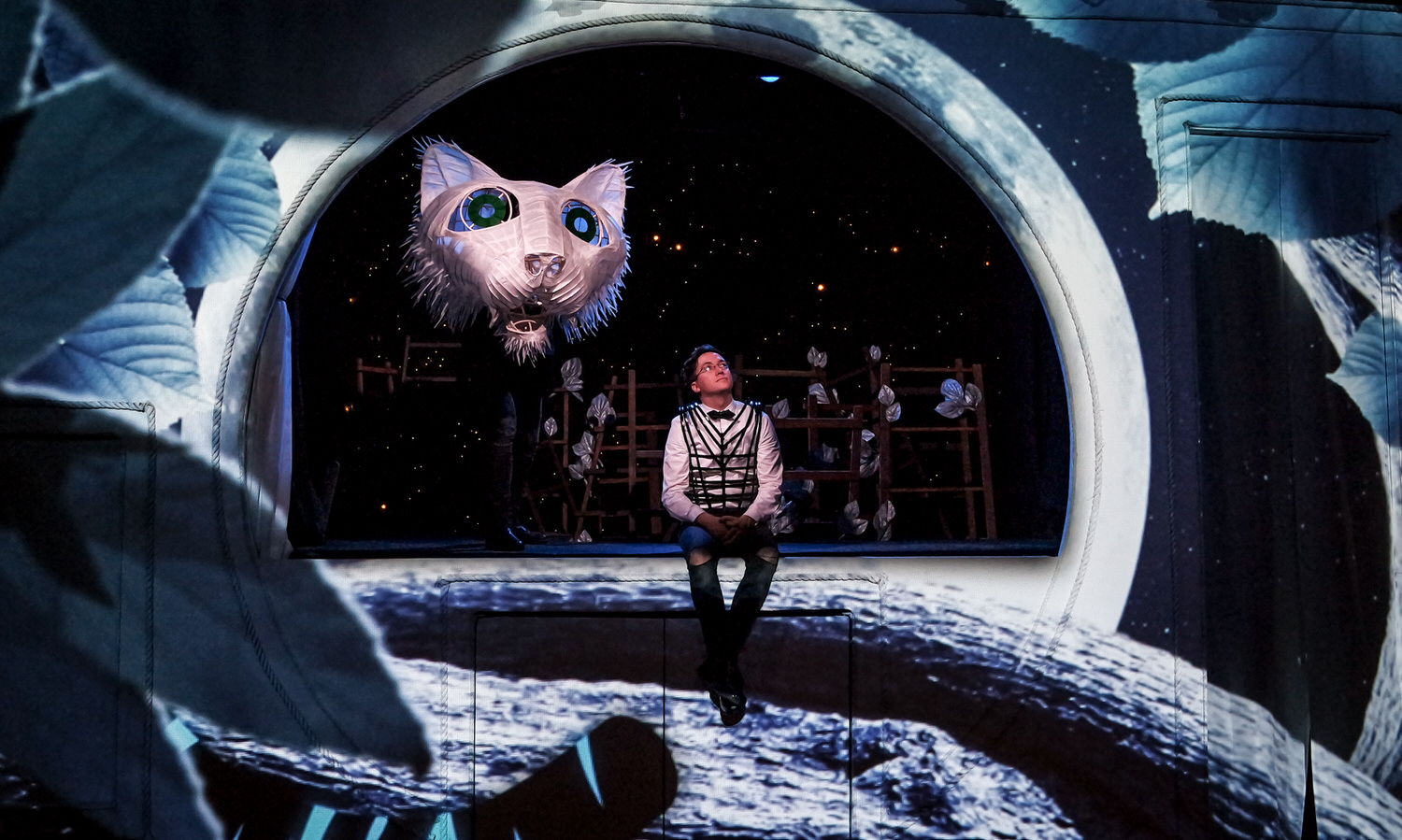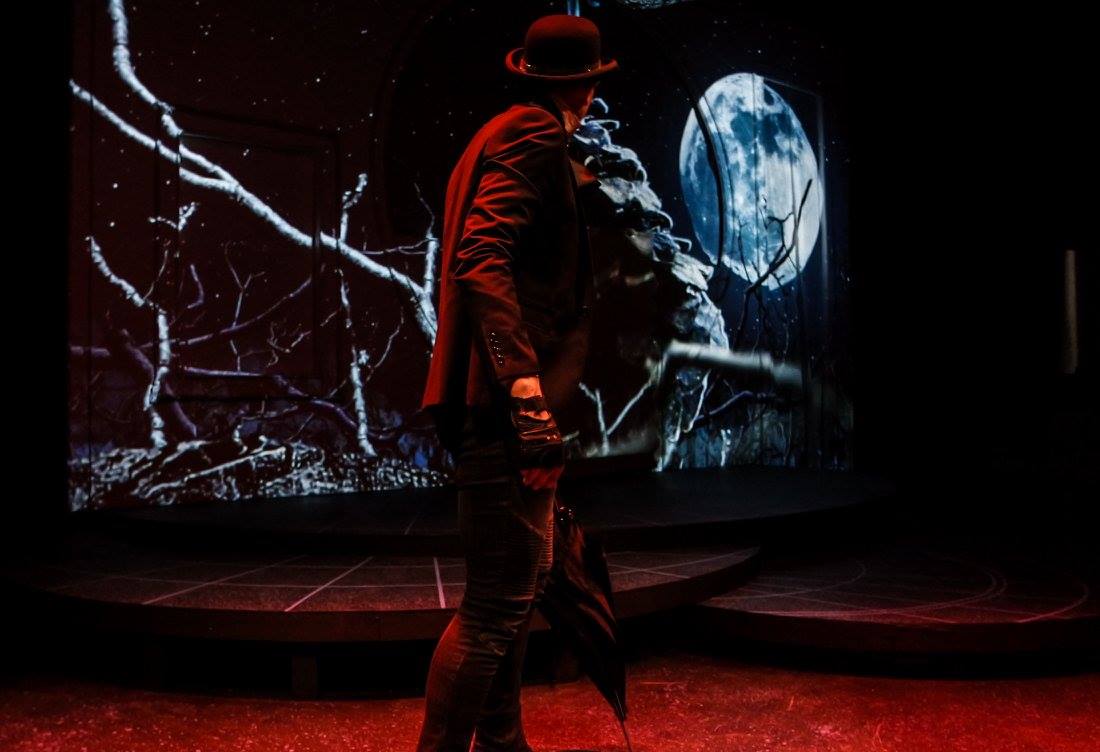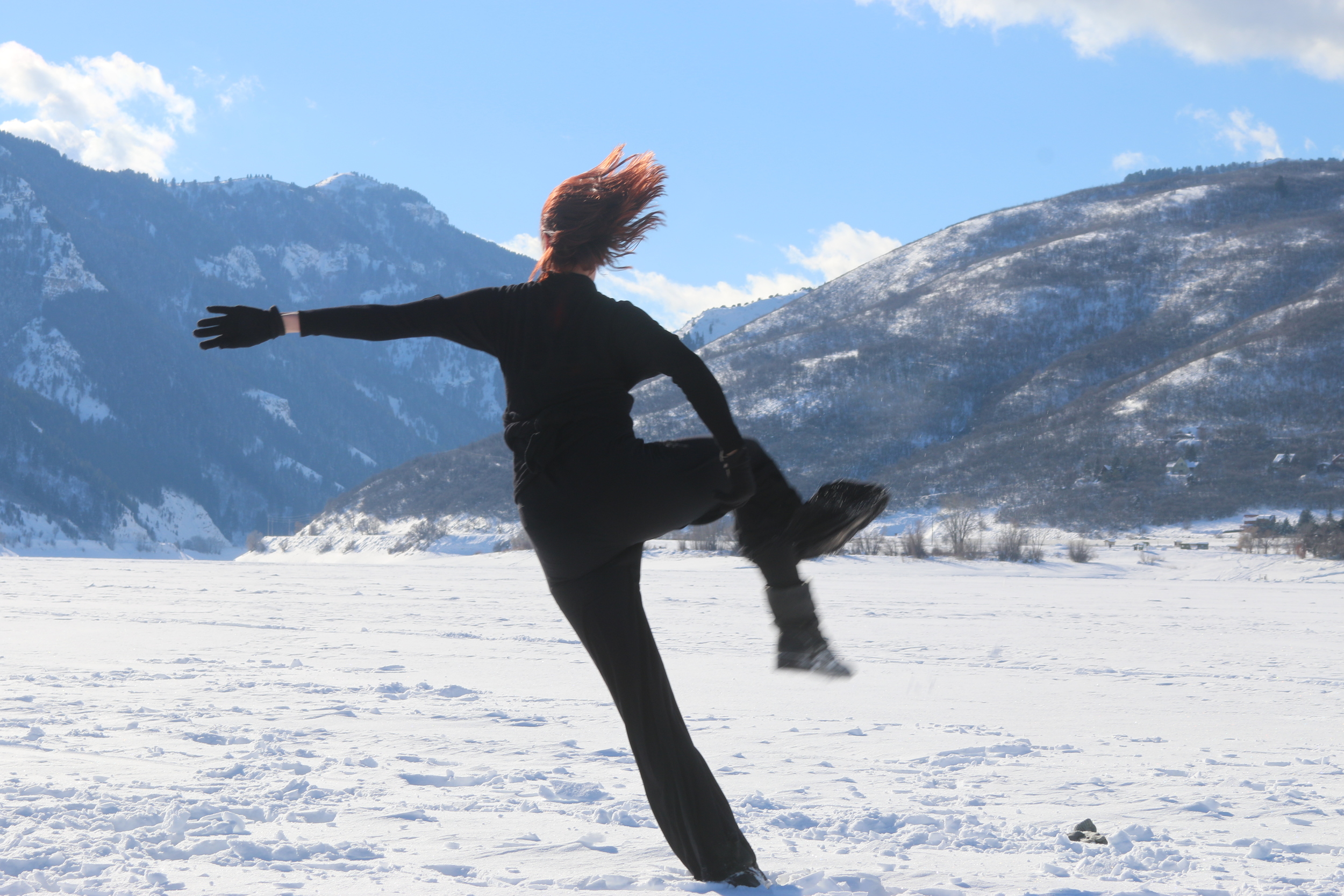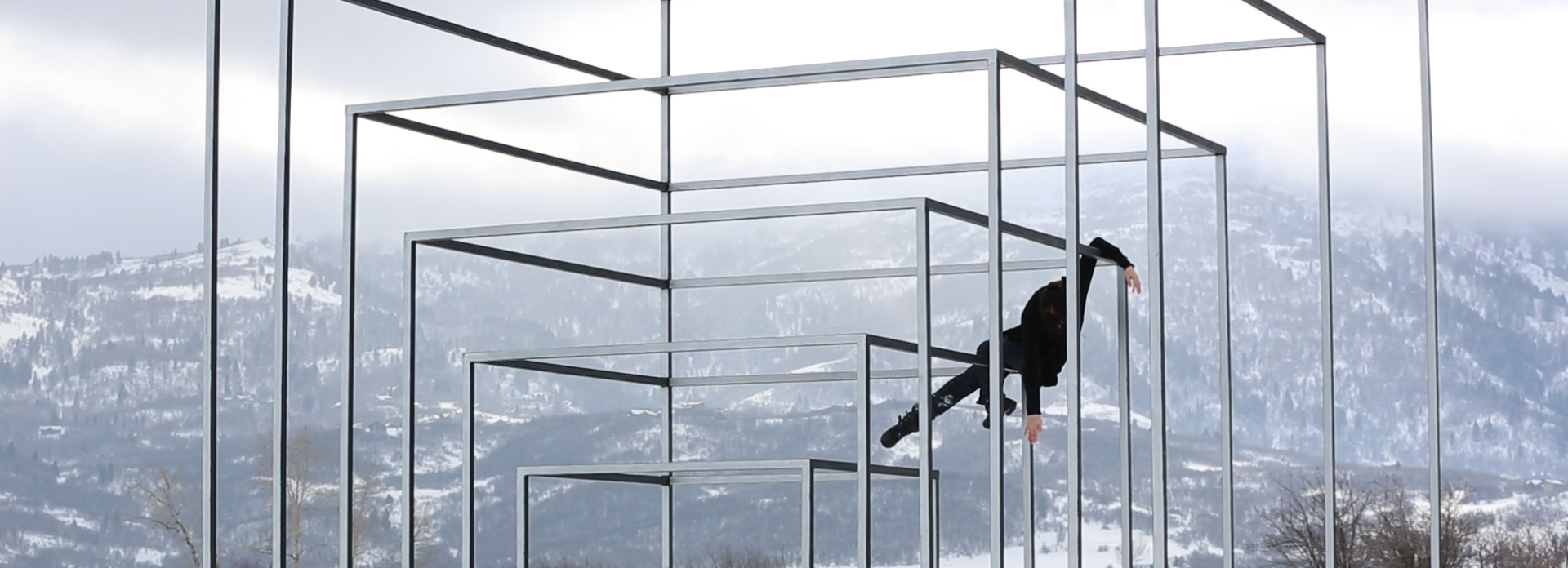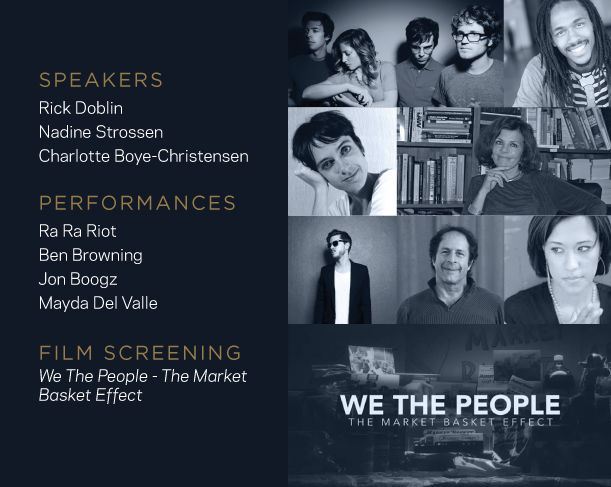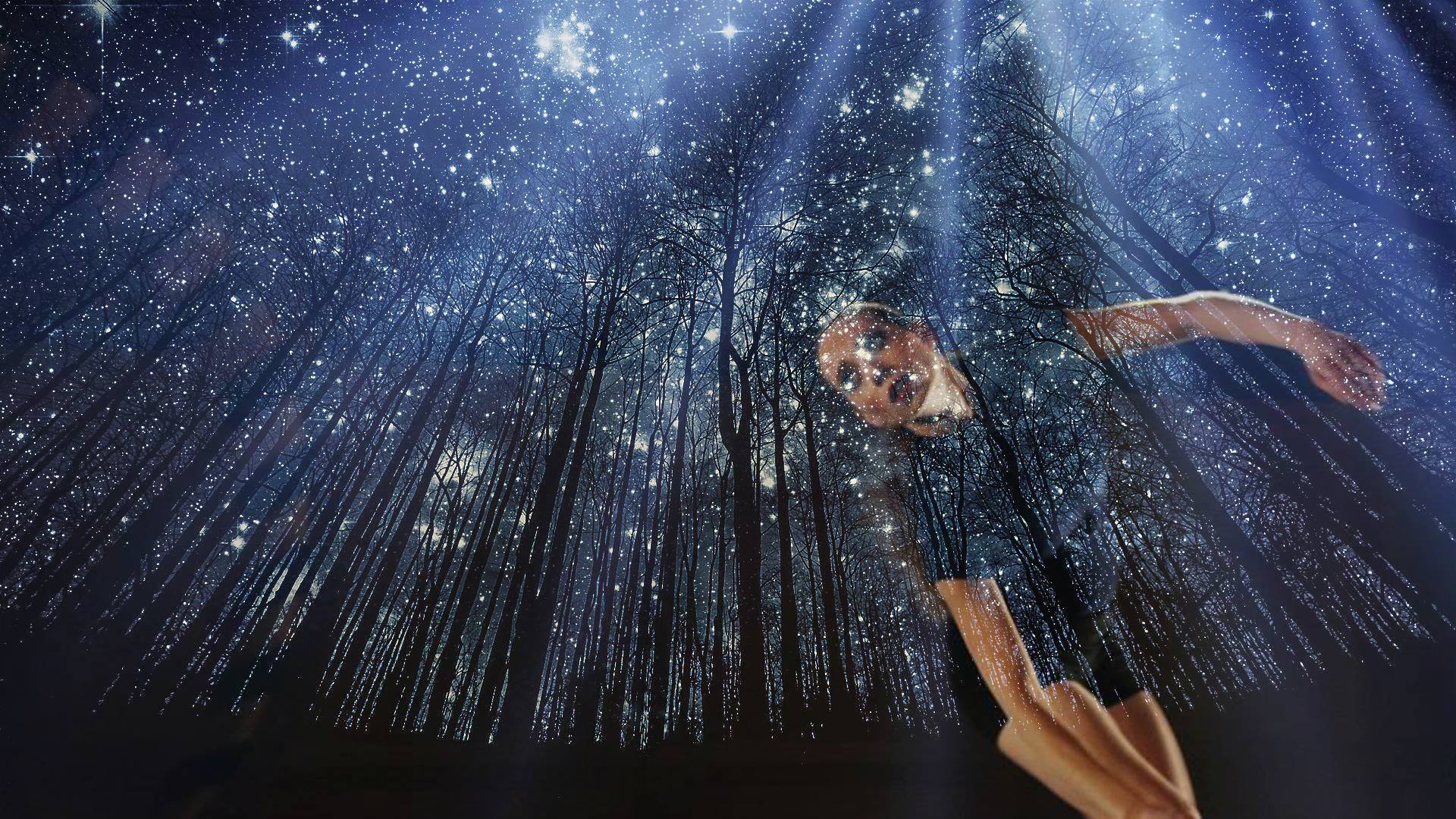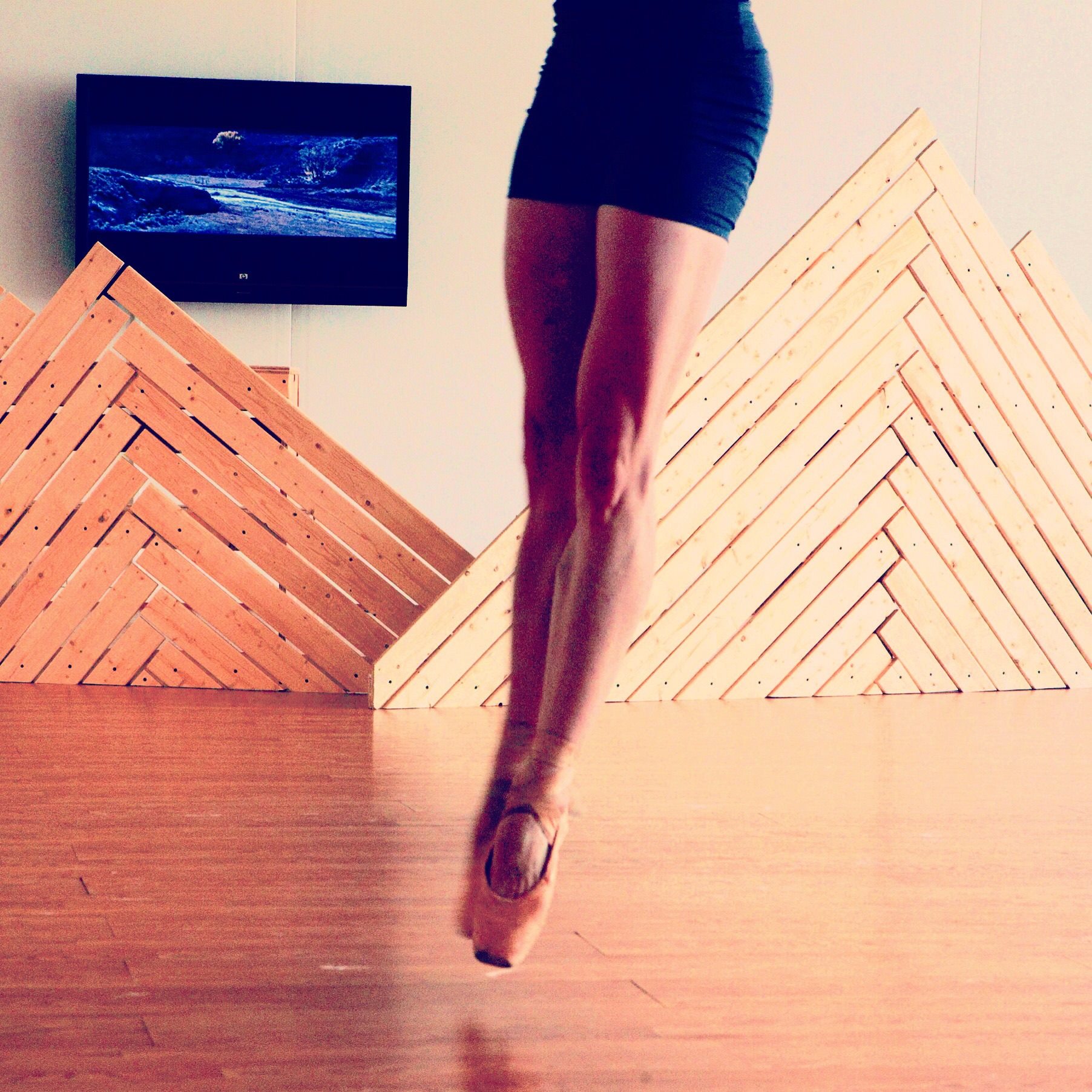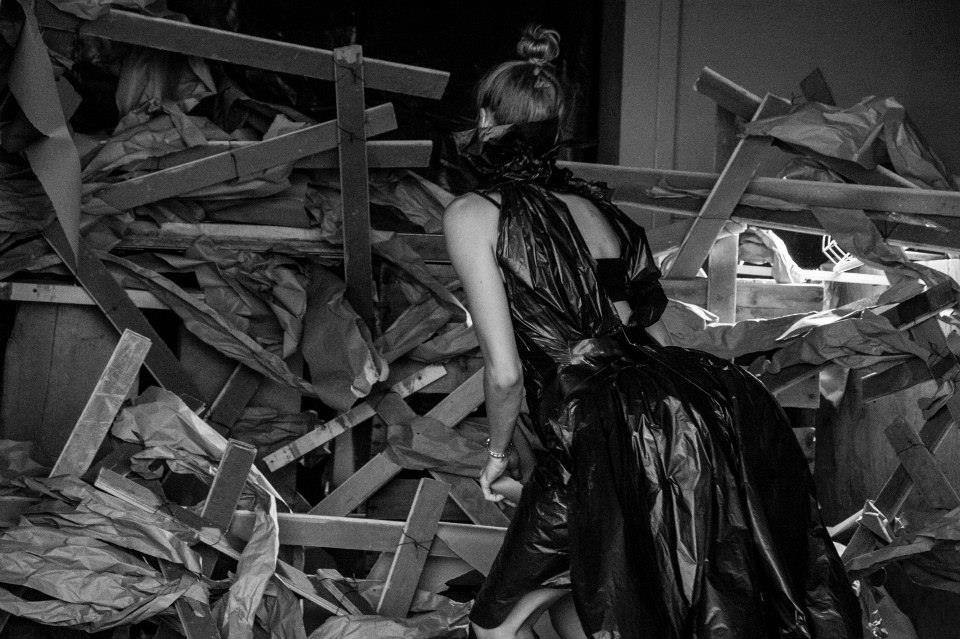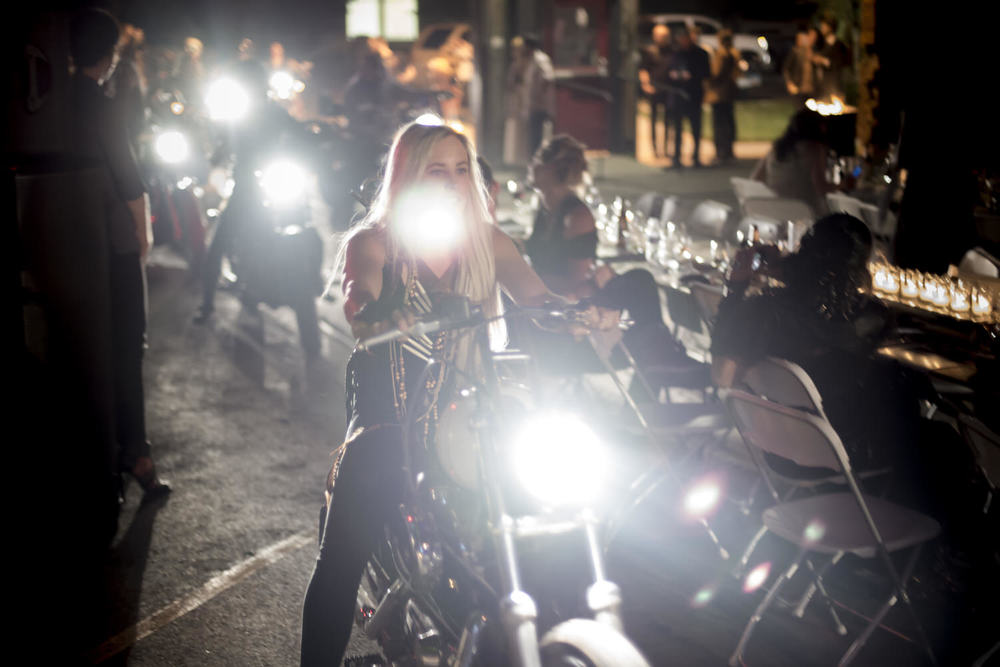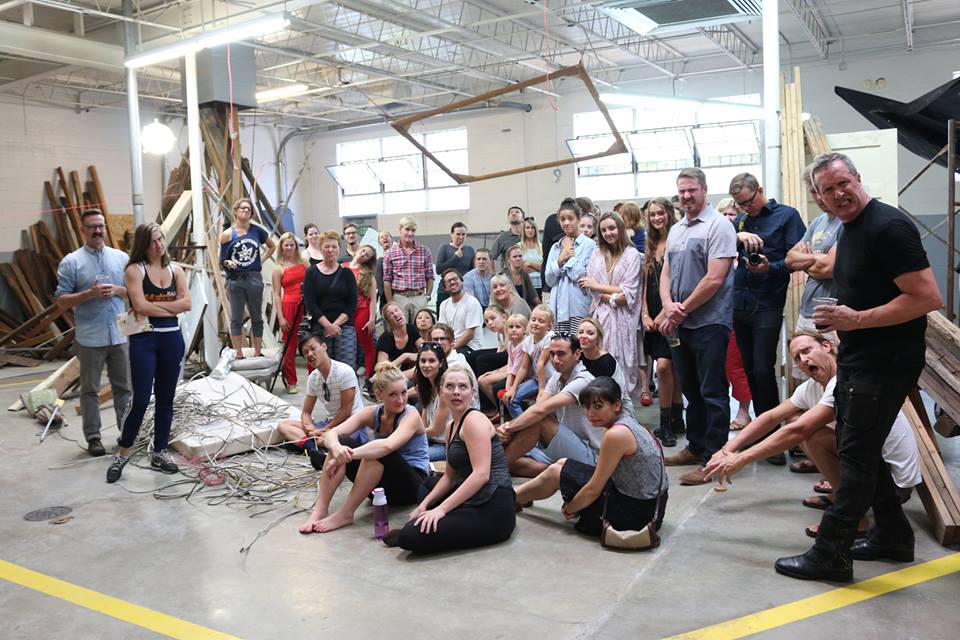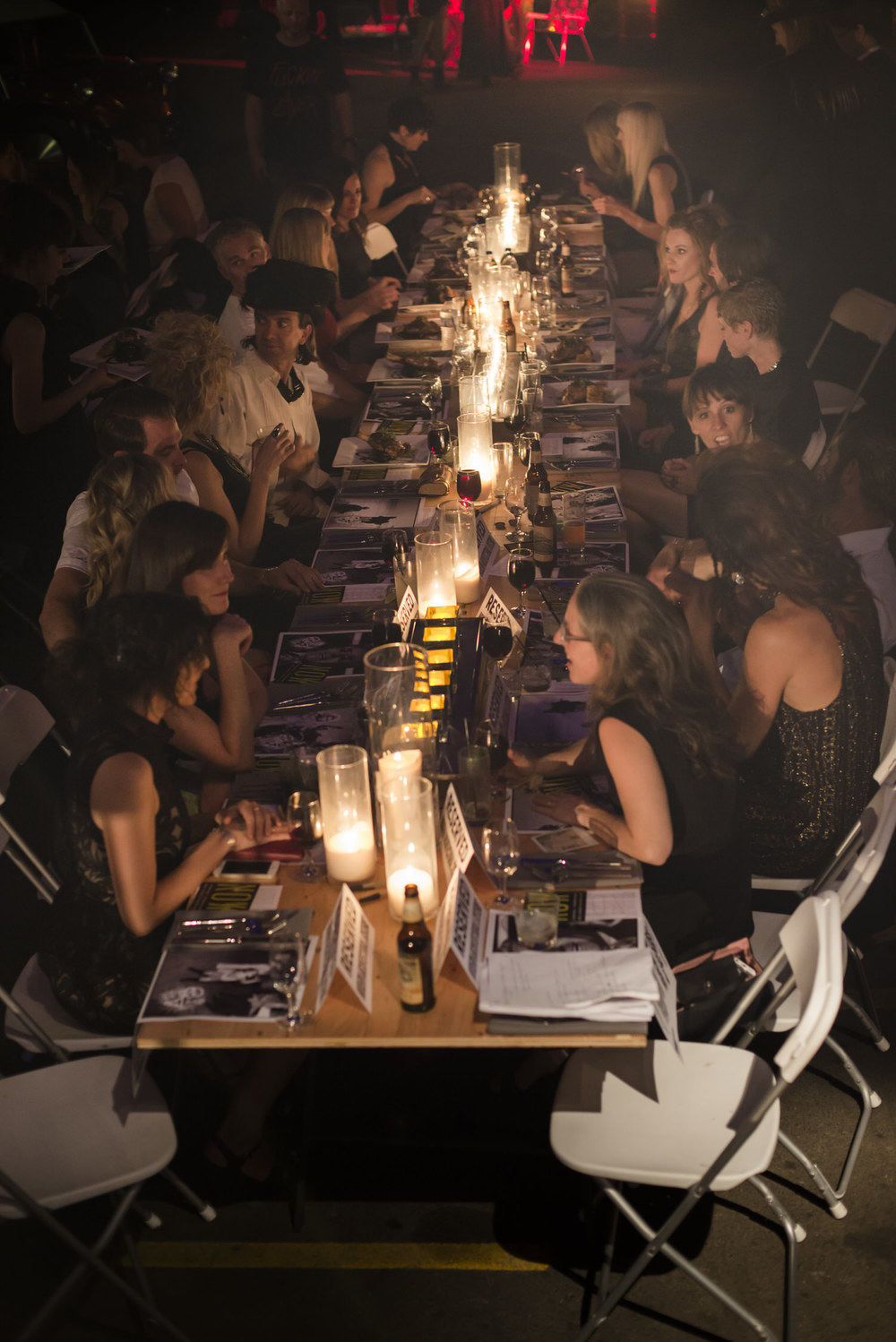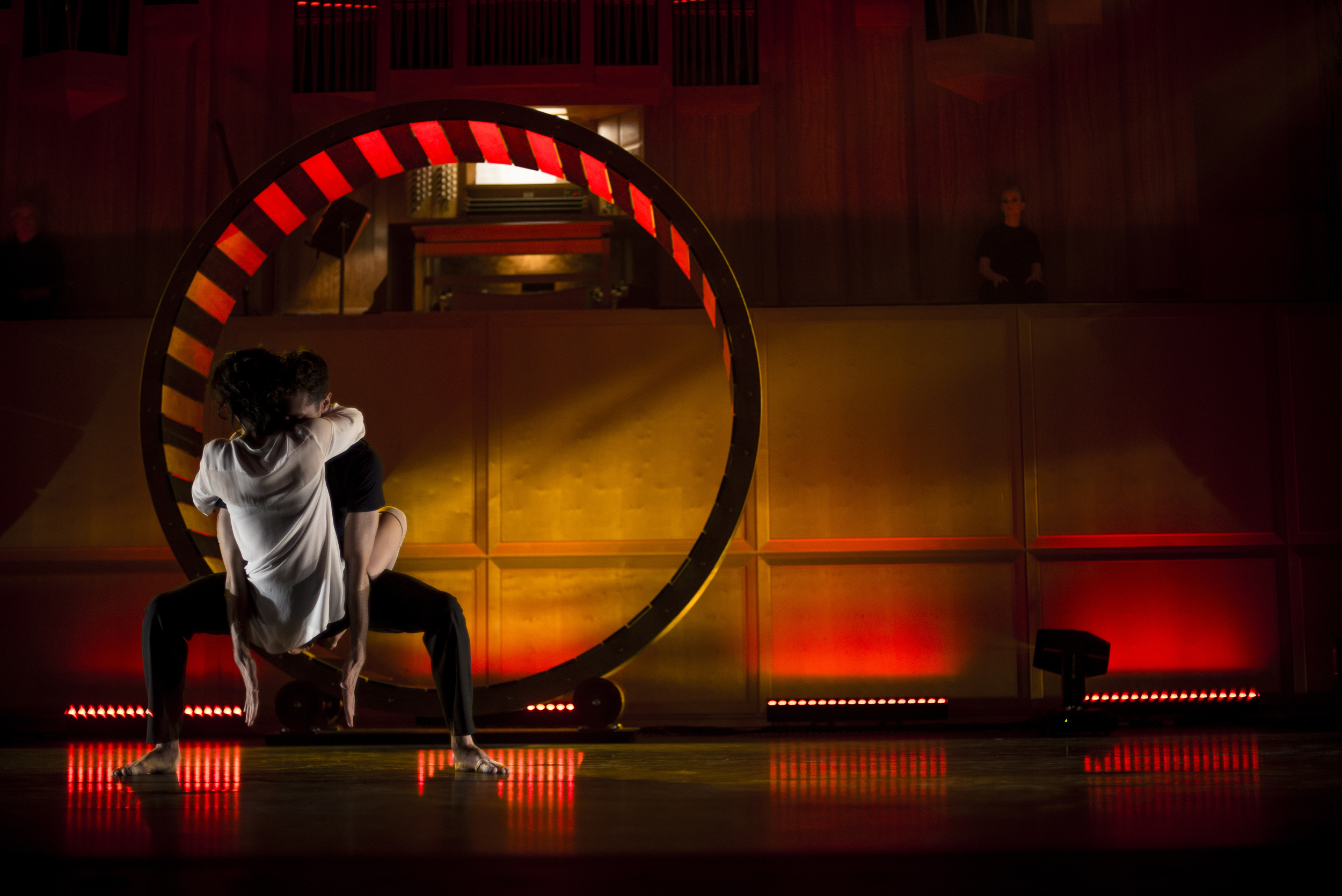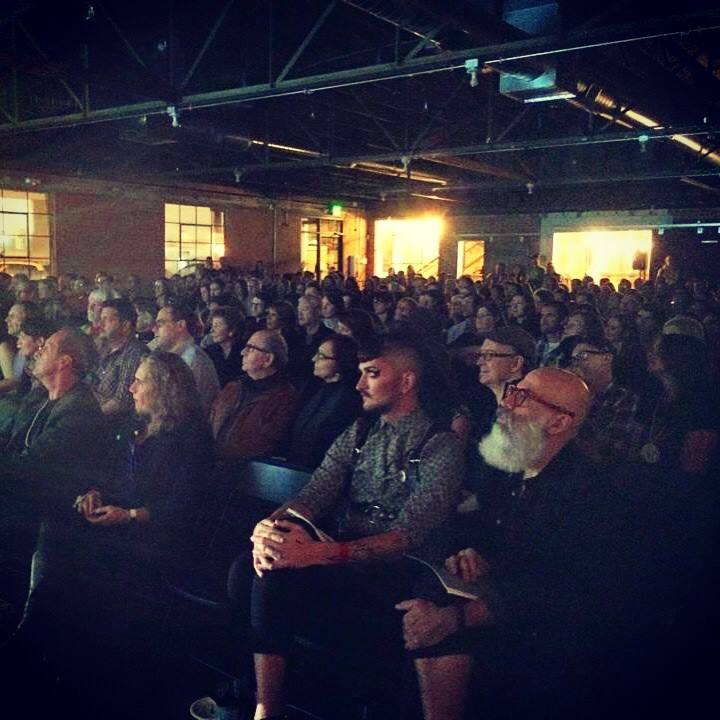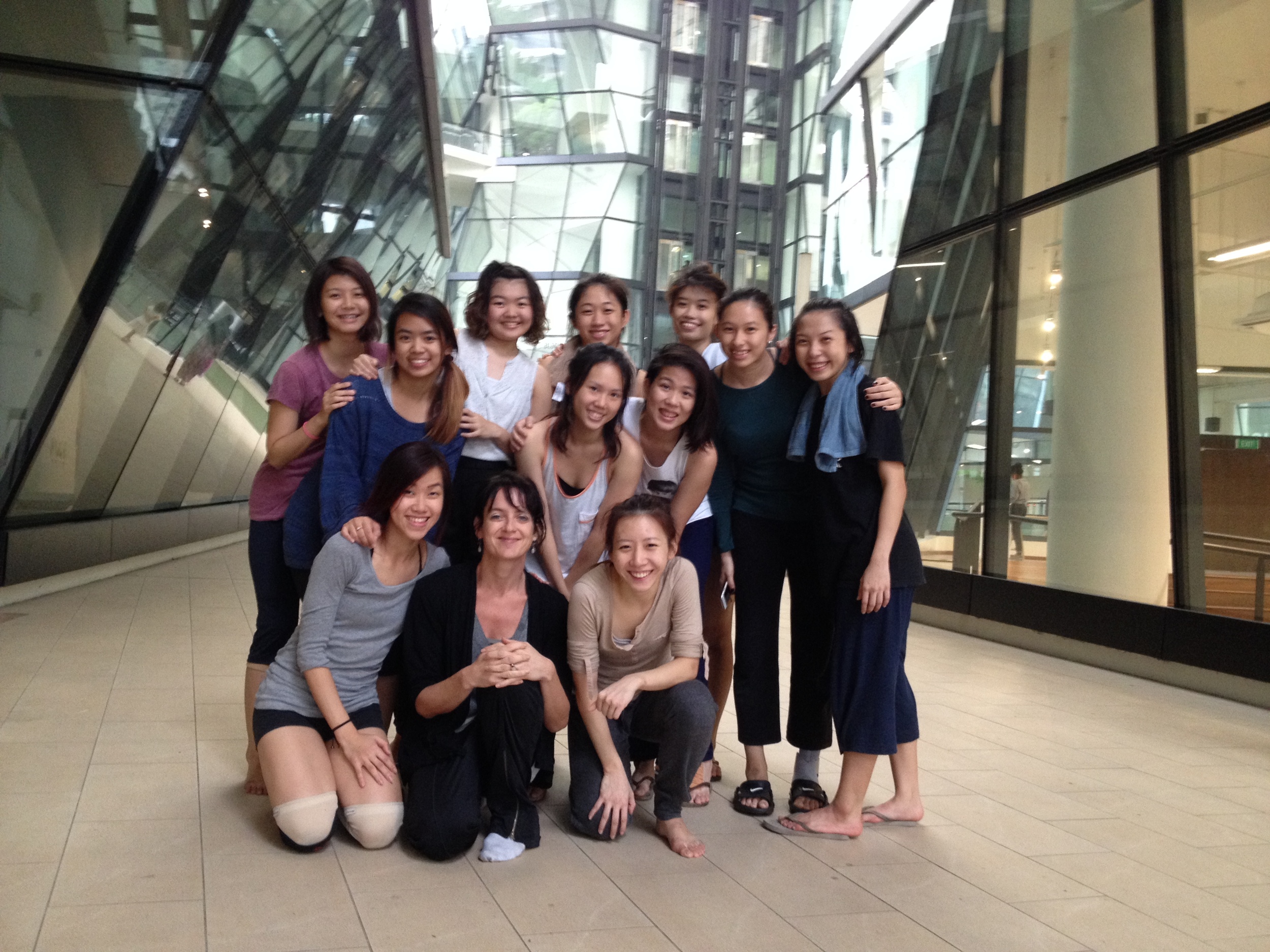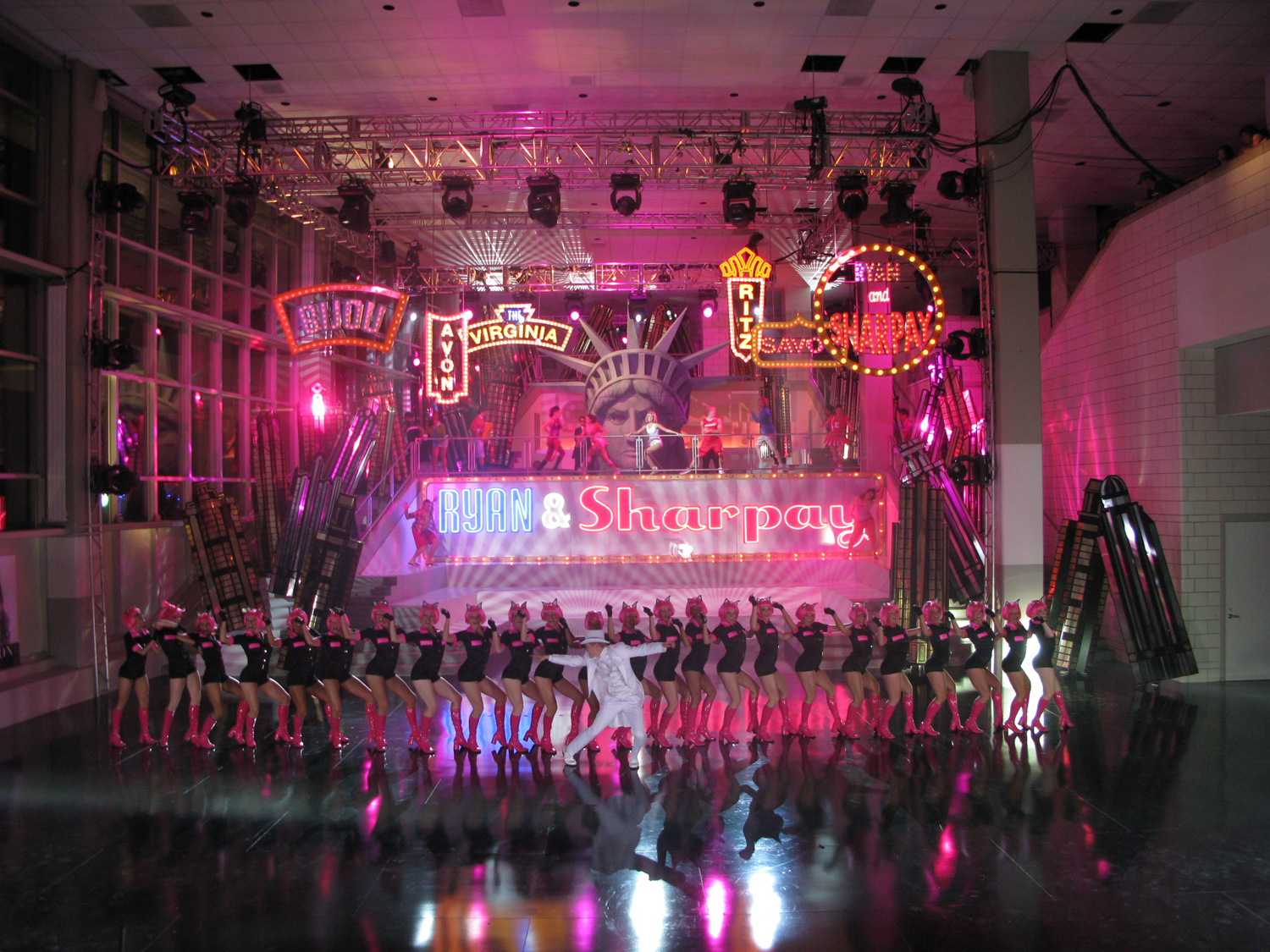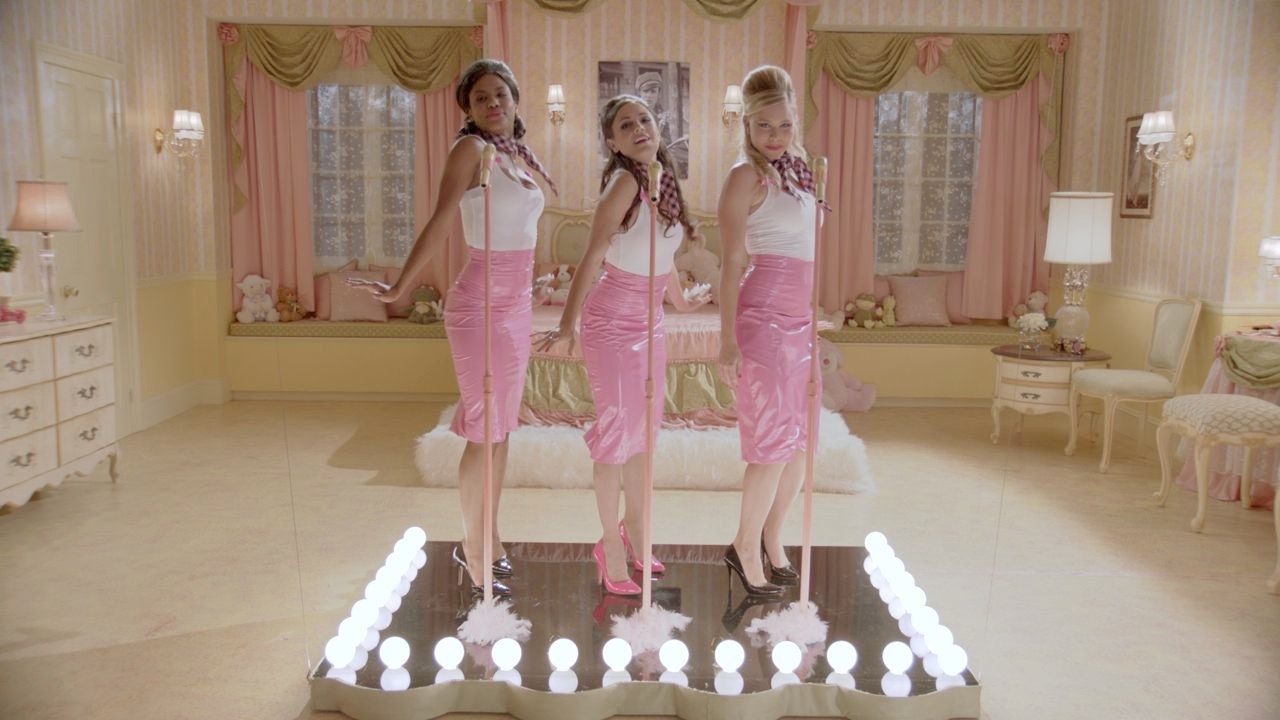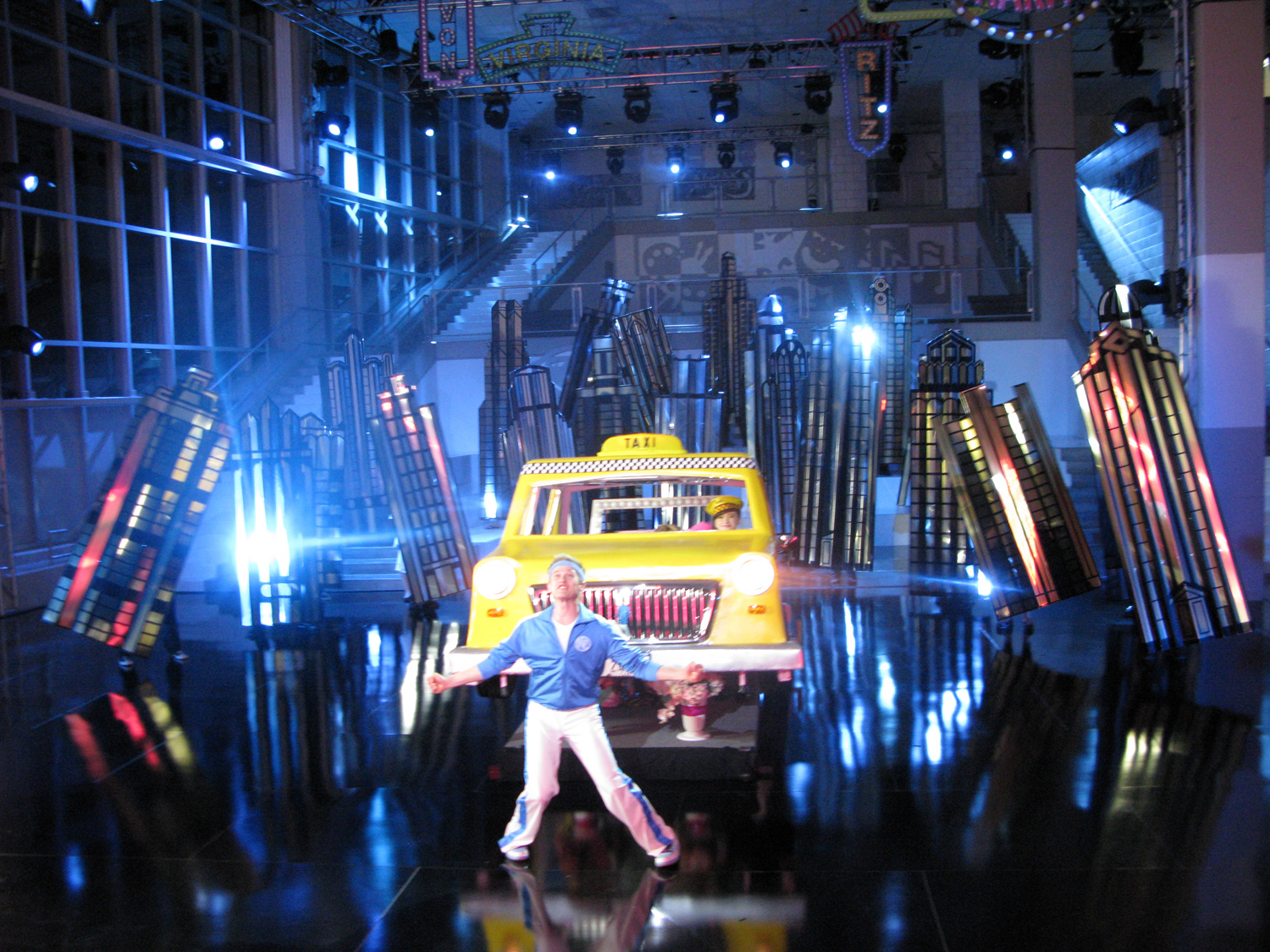Nana Bugge Rasmussen, one of the opera singers in our upcoming production EXODUS is educated at the Universität der Künste, Berlin, and at the Royal Danish Academy of Music, Copenhagen.
She says the following:
"I’m very exited about Exodus, mainly because I think cross-over performances can be so interesting when the different elements work together in new ways, and specifically because the theme of Exodus, which is people moving across borders, is so present in the world today, and yet so often viewed only from a political or economic perspective. In Exodus we intend to look at it from a human perspective. It will be challenging and rewarding."
We are having an EXODUS dinner party on July 29th, where you get to meet all the local and international artists involved. /
Tickets on sale for EXODUS. Come join us in July! /
Photos by Jeffrey Juip from Space As Collaborator 2016! /
NE PLUS ULTRA: ARTIST/DESIGNER GARY VLASIC /
Gary Vlasic is an accomplished performer, artist, event-planner, designer and much much more! He brings an extraordinarily diverse background of mediums together to create unforgettable visual experiences. These encompass large scale events, interior design, art direction, performance, site specific design, and image making. For 12 years Gary performed with and was co-director of "A Company of Four" – C04. For the past 20 years Gary has worked extensively in the event and production design arena. His current project, V Project brings to life a studio experience with a diverse team of collaborators and talents to explore the boundaries of art, design, and architecture.
Gary Vlasic is a collaborator and Board member of NOW-ID. I have personally known Gary for 16 years - I met him in connection with one of my first projects in Salt Lake City in 2000. He is forever curious and pushing boundaries - his input and output is extraordinary and I adore having him as a friend and as a creative confidant.
Gary is at the moment working on an art installation with fellow artist Colour Maisch titled "ALBEDO/NIGREDO. It opens at Finch Lane in Salt Lake City on June 17th, 2016 and runs through August 5th, 2016.
Enjoy!
Charlotte Boye-Christensen
Please tell us a little bit about your background? You trained originally as a dancer - how do you think that early training helped shape what you are currently pursuing as an artist and as an event planner?
My dance training was from the University of Utah's Modern Dance Department. I had started with ballet training quite late and studied in a small studio on Floral Street from a teacher from Russia: Professor Ratimer Antik. Russian Ballet training for two years led me to the University of Utah. I started dancing at 21 years old and had little time to catch up and find my place in the dance world. I knew I wanted to do my own work and I partnered with my two friends Mark Lowdermilk and Susie McGee in a company we called CO4 / Company of Four. We had that dance company for 12 years. Our work became strictly Site specific work over the 12 years of exploration together. As I look at my art life and my work as an event designer and producer, I realize that my dance company experience and choreographic experience was the core of my business and art making. In the dance world I was able to wear so many hats, Choreography, Stage Design / Set Design, Lighting, Costuming. Architectural considerations regarding Site specific work allowed me to consider how that site influenced and informed the dance theater performances I created. I found a natural transition to Event production and design as these tools were exactly the foundation to my business and my art projects and art production.
Tell us a little bit about your creative process as an event planner, a designer, and as an artist? Are those three processes distinctly different or do you see similarities?
I have found that my design mind and design process works hand in hand with my art process. Creating from a design eye first actually helps me to frame my work and inform it in a way, where it has a strong structure. That said, I also believe that the art process is a completely different influence and has it’s own process and voice. I try to link these two worlds together. Sometimes it isn’t successful. For me, it all comes down to good theater that provokes and hopefully leaves us with an impression and moves people to tears.
I get the impression that music is important to you - can you talk about why? Who are two of your favorite composers/musicians?
I always begin with music and sound scores to all art and theater productions. It seems that a score or piece of music can inform the whole structure and core of a work. I find that soundscapes are my greatest influence and I look to composers, who create strong environments with sound. I am currently Influenced by Hans Peter Kuhn and Jonathan Belper. I am influenced by all classical music as well as pop. The tension and juxtaposition can be powerful.
What fashion designer do you look to for inspiration? What architect? What product designer? What artist? And why?
Fashion designers: Rick Owens, Sruli Recht, Craig Green and of course Alexander McQueen. Architect Inspirations: Rem Koolhaus, Diller Scofidio + Renfro and anything Brutalist. Product designers : Rick Owens Couture design in Furniture and Faye Toogood/Toogood design. Artists: Cy Twombly (his paintings make me cry) Neo Rauch (His paintings make me want to create theater around them), Anselm Kiefer (His work and scale inspire me to think big), Banks Violette (His work provokes and his materiality speaks to me).
I saw an interview recently, where you talked about the "Darker Edges" being interesting to you - what do you mean by "Darker Edges"? And why do you think it is important to embrace those sides of yourself?
I find that most of my artwork and process is informed by a dark edge. The dark exploration combined with emotional content can shake down and provoke us to dig deeper. It is our jobs as artists and theater makers to make people see things and feel things that an edge from a darker reference can move us and transform us to do. It is important to feel uncomfortable and restless in these visions. Within all darkness lies a thread of light and lightness.
If you weren't living in SLC, what would be your city of choice and why? What city currently do you think generates the most interesting art and design?
I am fortunate to have a dual life that allows me to be in NYC and home based in SLC. Of course, NYC offers me a huge luxury to see and experience the world of art and theater and allows me to do my constant homework. I seek inspiration all the time. I am blown away with the realization that so much good artwork and design is coming from great cities all over the world. I don’t see that one city or part of the world is any more inspired. We have the ability to connect to the world and experience all these good influences from our screens and that is very exciting.
I know that 'alone time" is important to you, what is it that you generate from being alone and do you feel that it is an important component in your creative process?
I find that my art process and internal process needs to find refuge in being alone. I admit that I feel more sensitive as I grow older and with that sensitivity is a need to protect myself and my process. I am less available and more economical about who and what I give my energy to these days. I am most true to myself and my process when allowed the luxury of time and space to create and to gather myself. I find that my work has clarity and meaning through process and time alone.
I love that your mind seems to be continuously creatively alert, how do you retain that curiosity in the world and act on your instincts? There seems to be very little fear in the choices that you make...
I appreciate your comment Charlotte. I do feel that I am always looking for the inspired moments and creative surge. It is all around us. I have always had a restless desire for looking and searching. It is my homework. I think it shows in peoples' work, when they don’t do their homework and see what is happening in the world and in their art forms. It is our job as artists to seek and question. It is a process of constantly unlearning what we know. Also, we must remind ourselves to be gracious to everyone in that process.
What is your favorite quote?
Artist : Teresita Fernandez :"Being an artist is not just about what happens when you are in the studio. The way you live, the people you choose to love and the way you love them, the way you vote, the words that come out of your mouth, the size of the world you make for yourselves, your ability to influence the things you believe in, your obsessions, your failures — all of these components will also become the raw material for the art you make."
If you could only bring 5 things with you to a remote island, what would they be?
1- Fire making, 2- Music, 3- Unlimited pencils and paper, 4- A companion, 5- A boat (haha).
Where do you see yourself as being and doing in 25 years?
I see myself surrounded with beautiful artwork, creating art and experiences and being sustained from this art life that I have been seeking and expressing. Sharing it with deep generosity. My life as a museum.
Showing at the Leonardo Museum in Salt Lake City tomorrow at 6pm of the work that was created at Space As Collaborator 2016. /
NE PLUS ULTRA: DRAMATURGE ALEXANDRA HARBOLD /
Alexandra Harbold is a director/actor/dramaturge living and working in Salt lake City. She founded "Flying Bobcat Theatrical Laboratory" together with actor Robert Scott Smith in 2013. "Flying Bobcat" produces and creates performance based works. Additionally Alexandra has worked with local companies: Salt Lake Acting Company, Plan-B and Pioneer Theater. Alexandra and Flying Bobcat Theatrical Laboratory collaborated with NOW-ID back in 2014 on our dance-theater piece FEAST out at the Great Saltair.
I had the privilege of working choreographically with Andra on FEAST and she has such powerful internal strength, vulnerability, fearlessness and integrity in the choices she makes in the creative process. On top of that she has an intuitive musicality, sensuality and intellect that she readily accesses and a natural affinity for movement. She is indeed a force to be reckoned with!
Enjoy!
Charlotte Boye-Christensen
Tell us a little bit about your background - I know that you studied at Goldsmith's College in London amongst other places, why did you choose their program? And did you originally train as an actor?
I did originally train as an actor. I went to the University of London Goldsmiths College after working with director Nesta Jones my senior year at Middlebury College, where I earned my undergraduate degree in Theatre. I wanted to continue training with Nesta and to have the opportunity to study in London.
What do you enjoy the most: acting or directing and why?
I truly love both, but directing is more intuitive for me. What I imagine creating is often beyond what I can do as an actor or as an individual artist. What Tamilla wrote about the actor’s art also resonates very strongly for me – and as an actor, I don’t think I’ve ever achieved the presence, risk, and alignment with the work that she articulates so beautifully – I do keep hunting and striving for it, and I am thankful for directors who challenge me to go further. I recognize it in other actors.
Tell us a little bit about your creative process as an actor and as a director- are there similarities?
My creative processes as an actor and as a director overlap. Whether it’s an existing play or a devised project, once I’ve read the play, I start digging and hoarding research, images, and music which feel connected to the text - feeling around for my own instincts about the play, its core question. It helps me recognize the play-world of the production we’re creating, its idiosyncratic beauty and rules. As a director and actor, it feels like the process is to align your own curiosity and appetites to the living questions in the text. When I first started acting and directing, it felt like there was a mysterious and elusive “right” way to approach a text – a target that you either hit or didn’t (I often felt like I couldn’t see the target, full stop.) Now I’m hunting for the unique alignment of that text and that company of artists – recognizing the possibilities that are only present because of that gathering of creative minds. Rehearsal is a process of drafting, layers, and constellations.
Why did you decide to create the company "Flying Bobcat" with actor Robert Scott Smith, what void did you feel that it was filling and can you talk a little bit about the philosophy behind the company? How do the two of you compliment each other?
Scott and I started collaborating together when he returned from NYC to serve as the Creative Director for the Leonardo Museum. He had developed a program called POPUP@Leo to create devised work and invited me to play on the inaugural project. Our first project, SENSES 5, led to our collaborating on two other devised POPUP works in the same year, LOVE and MIND OVER MATTER. When we began, we started from the ground with only raw ideas about a point of departure or how we would develop the work; in a very short time, we’d forged a working method and shared language that we continue to use and expand upon now. We both respond very strongly to mythos, design, movement, and music. We were also hungry for the kind of work and experimentation that we saw in London and New York.
I think we complement each other because our imaginations are both kindred but distinct, and we call out each other’s strengths and push each other. A strength I believe we share is recognizing collaborators who create the visual and aural worlds we dream about – we couldn’t do the work we want to do without them.
Our latest project with Salt Lake Acting Company and Dallas Graham’s Red Fred Project, Climbing with Tigers, is a perfect example. Scott asked our Feast collaborator, Playwright Troy Deutsch,to adapt Nathan Glad and Dallas’ book for the stage. He then asked SLAC if they could give the project a home. Scott’s asks and Troy and SLAC’s generous yeses led to the opportunity to assemble a creative force of artists.
There is a strong visual, almost cinematic component to the work that you are doing with "Flying Bobcat" - is that important to you in creating new work? It doesn't strike me as being naturalistic theater that you are cultivating; instead it feels fiercely experimental, which is exciting - was that also why you called it a Laboratory?
Both Scott and I are drawn to the immersive, shape-shifting play-world possibilities that working with film and projections creates. And yes, thank you! I love “fiercely experimental.” That’s exactly why we included Laboratory to our name. We wanted experimentation to be at the very core of our creative identity and company mission.
What excites you about being based in Salt Lake City as an artist and what do you miss from being based in a bigger city? Do you feel that there are limitations/restrictions in working here and also what are the benefits/sources of inspiration?
I find Salt Lake City exciting because there is an appetite for experimentation and the work that coexists with a strong sense of home and community. A bigger city would allow for greater cross-pollination of creative ideas. I think more exposure to artists from around the world would galvanize our own work and encourage us to take bigger imaginative risks.
What city in the world do you see as having the most exciting theater scene and why?
I find London a thrilling and vital theatre city (Complicite, Frantic Assembly, the Court, the National, et al) – not only for the work created there, but for it as a crossroads for international theatre. It also feels like home to me. NDT and Ivo Van Hove’s Toneelgroep Amsterdam tempt me to visit Amsterdam.
Tell us a little bit about the highlights of your career so far? Climbing with Tigers is certainly a highlight. Working with Animator & Graphic Artist Jarom Neumann as he created the visual world of the projections was a particular joy. Tribes (Salt Lake Acting Company) and Picnic (The Grand) this year were also landmarks for me as a director. As an actor/performer, working with you, Scott, Jesper Egelund (composer/musician), Troy, Jo, Yumelia, Jenn (dancers) and Nathan on NOW-ID’s Feast.
Who are some of the people who have inspired you in your work and why?
I am inspired by Director Mary Robinson every time I get to be in the room to witness her work. Her attention and questions stir up something electric in the work – nothing is incidental. Anne Bogart and Tina Landau (The Viewpoints Book) have transformed the way I see space and staging – and they’ve taught me to embrace “exquisite pressure".
Scott Graham and Steven Hoggett’s The Frantic Assembly Book of Devising Theatre – their generosity with sharing their secrets so we can all experiment.
What is your favorite quote?
Two came to mind. “Ever tried. Ever failed. No matter. Try again. Fail again. Fail better.” Samuel Beckett "Always the beautiful answer who asks a more beautiful question” e.e. cummings.
I asked this question of Director Tamilla Woodard and I want to ask the same of you because I think it is an important one: Have you experienced sexism in your work as a Director and if so, how have you dealt with it? Do you see more female directors working in theater today compared to when you started?
It is important. I’ve encountered sexism as an actor and director - some inadvertent - some more intentional - rationalized and self-justified, which feels more corrosive in a process. Directing offers creative agency and a defining voice in the process. It also affords the opportunity and responsibility to imagine and to facilitate a different conversation in the room and in the work. I have had the opportunity to work with and witness the process of many incredible women directors: Mary Robinson, Karen Azenberg, Robin Wilks-Dunn, Adrianne Moore, Shana Gold, Julie Kramer, Anne Bogart, Cheryl Faraone, and others. As a director and teacher, I work to support and mentor other female directors and actors.
As an actor - what director have you always wanted to work with (Dead or Alive)? As a Director - what actor have you always wanted to work with (Dead or Alive)?
There are so many. As an actor and director, I would love to have the opportunity to work with Complicite founder Simon McBurney. As a director, I would love to work with actor Helen McCrory.
Tell us a little bit about some of the projects that are coming up for you and that you are excited about?
There are two projects that I am excited to collaborate on that will go into production early in the fall. I am dramaturging Pioneer Theatre Company’s The Last Ship, with music and lyrics by Sting and book by John Logan and Brian Yorkey, directed by Karen Azenberg. I am directing the University of Utah Studio 115 production of Carson Kreitzer’s Self Defense, or Death of Some Salesmen, based on the story of Aileen Wuornos.
Looking towards the future where do you want to be and what do you want to be doing in 25 years?
Having adventures with (my husband) Joe and creating work with friends who challenge and inspire me.
The Site for our Space As Collaborator 2016 workshop is exciting and thought provoking! /
NE PLUS ULTRA: THEATRE DIRECTOR ROLF HEIM /
Rolf Heim, Director
Born in Switzerland Rolf Heim trained as an actor at the Institute for Stageart in Sweden 1984-1986 and later as a director at The School of Stage Arts, Theatre Cantabile, 1989-92. With actor and playwriter Claus Beck-Nielsen under the name 20th Century Ghost he directed the plays: Andy Warhol, Rupies and Balls and Theatre Butcher. Rolf Heim is artistic director of the Boat Theater in Copenhagen, where he has staged numerous productions. Aside from this appointment there he has also staged Miss. Julie at the Kaleidoscope Theater for which he received the significant Danish theater acknowledgement: The Reumert Prize, and later the Nick Cave Theatre concert at Aarhus Theatre in Denmark.
Rolf is part of the collaborative team for NOW-ID's next big production EXODUS - we are excited to see his incredibly creative and original mind set in motion. Please see our most recent NE PLUS ULTRA interview here.
Enjoy!
Charlotte Boye-Christensen
Tell us a little bit about your background; you originally trained in dance, why did you make the change to theater or was it more of an organic evolution as opposed to an intentional decision?
I only worked for a short period of time with dance and as I am not a trained dancer, physical theater was always my main focus. Already as a child I expressed my emotions physically, when I was happy I had to run or dance and when I was sad, I went for long walks.
How do you think your background in movement has influenced your work in theater?
It clearly gave my work a very physical and visual expression. For me it was never enough as a director to have actors who only felt something on stage, I wanted to see that emotion in action, expressed through the body. My work on stage is seldom traditional or naturalistic - it always has a physical expression.
Your work strikes me as having a really strong stylistic point of view - interpreting a text through movement language seems important to you - can you talk about why? Also, on that note I loved hearing about your puppet theater piece "Jernring" (Iron ring) - what can Puppet Theater add to your form that you wouldn't have been able to achieve through human performance?
Theater is a "live" event, things are happening right now on stage for the audience. So energy is important. I want to see and feel the actors at the same time. To only pretend is not enough.
Puppets are magical as they only come to life through animation. An animated puppet is still not a living human being, but it gets life, or becomes alive through the imagination of the audience. It is in the mind of the audience, that the puppet gets feelings and movement. On stage you see the actors, how they move a puppet, but as a spectator you choose to believe that the puppet is alive. We become like children again playing with a toy, giving life to it only by imagination.
So engaging the public, without them being aware of it provides them with a more powerful experience. And a puppet is never embarrassing or too sentimental, etc., something, you can't always say about real actors.
Do you consider your work to be more performance art than Theater and in reality do these kinds of terms and distinctions even matter anymore in talking about performances?
My work is very much influenced by Performance Theater. Meaning - there is no hierarchy between text, light, set, actions, actors, and so on, everything or any effect can be used in order to resolve a scene or tell at story. Normally in theater, the actor and his/her text is the most important thing, the rest is just decoration.
Do you see a difference in the direction that theater/performance is heading in Europe compared to the States and can you talk about what those difference are? Also, what city in your opinion has the most exciting contemporary theater?
I do not really know so much about the theater in US. But in Europe, it differs from country to country. Avant-garde and Performance Theater are both very strong in Germany, The Netherlands, and in Belgium. All of their city theaters are working with directors, who think about art and not only about the entertainment value. Theater is seen as an art form in those countries, it is well funded and has a public, which appreciates innovative theater.
Baadteateret
Tell us a little bit about "Baadteateret" in Copenhagen? It is quite unique because of size and placement - how do these features play into the shaping of your repertoire?
It is a unique and intimate stage with only 80 seats on a boat situated in the middle of historical Copenhagen. Perfect for Puppet Theater! We can afford to be experimental, because we are so small. Ticket sales don’t really influence our budget, as there are so few seats. So we focus on developing puppetry, doing research and having a laboratory attitude towards our work. Ironically, that has made us very popular and we often sell out our shows.
Tell us a little bit about the highlights of your career so far?
I think those shows where I worked very uncompromised, not thinking about success or how the critics would receive the work. Instead just following my intuition and taste. Those have become huge successes, which feels in a weird way very cool.
A show about Andy Warhol in the beginning of my career had that effect, and opened a lot of doors to the more established theaters for me. Then The Nick Cave Theater concerts became a huge thing some years later, and lately I would say “Jernring” (Iron ring), puppetry show on Baadteateret. So highlights for me are the ones where my innovative, artistic work reaches our audiences and critics.
What is your creative process like - is collaboration important to you and if so why?
More people have more ideas than one person. So I listen very much to my actors, sound, set, lighting designers. I always tell them that 80% of my ideas don’t work and that counts for every body. So throw in ideas, but do not insist on them.
I always know one moment at a time what we are heading for, but not where we end. Having a team, which works under those circumstances, demands that you as a director really motivate and lead...
Who are some of the people who have inspired you the most in your work and why?
"The Wooster Group" (a New York City-based experimental theater company known for creating numerous original dramatic works) because of the way they rehearse - they keep on trying things out, until it works. They also taught me, what musicality is in a dramaturgy, and the basic rules of Performance Theater.
Robert Lepage (A Canadian Theater artist) in his early years, showing magic realism on stage.
Peter Brook (A British Film and Theater director), because the research of an artist never ends.
La La La Human Steps (A Canadian contemporary Dance Company under the direction of Edouard Lock, which has unfortunately closed down in 2015) because they produced shows which can’t be further away from what you normally see on stage, but it knocks you out...
Where do you look to for inspiration? Do you watch a lot of theater in your spare time or are there other mediums that interest you more? There seems to be a real cinematic quality to what you do, hence my question.
Film yes, visual art in general, museums of any kind, kids playing, watching every day life and of course theater - mainly abroad.
What is your favorite quote?
"This little finger, still doesn’t obey me". Pablo Casals, a world known cello player, who has won every award you can win in classical music, and played all over the world. The quote was his answer to a journalist, who asked him when he turned 80-years old. 'You have reached everything a musician can dream of, what is left?
This became or is my main motivation in work, 'keep on developing, never stop...."
Who is the actor that you have always wanted to work with and what is the project that you have always wanted to do?
Actors - none. Projects - lots.
But my experience tells my, that when you after years of waiting finally are allowed to make your dream project, it becomes a disappointment. Dreams are here to be pursued but not to be fulfilled. So I turn it around and say, the project I work on right know, is the only one I want to do. And that works!!!
Looking towards the future – where do you want to be and what do you want to be doing in 25 years?
I will be 70-years old, and the answer is quite conservative: looking at my children and being happy about who they have become.
And besides that: painting, writing, taking a walk with my dog, ... and maybe doing a show once in a while.
EXODUS LAUNCH /
We are gearing up for our next big project
A co-production with Copenhagen based music ensemble Figura, EXODUS will be developed in Salt Lake City and premiere here on July 28, 29, and 30th. We will then tour this SLC-created work to the prestigious Copenhagen Opera Festival in August.
EXODUS will bring together 15 local and international artists, original choreography, opera, music, design, and dance in a stunning site specific venue. The work will explore the implications of mass movement, both individually and collectively.
All funds raised this year through Love Utah Give Utah will go towards the EXODUS project and we need your help!
Our goal is to raise $4321 in 24 hours. Ambitious – yes, impossible – no.
Please Donate now >
Today's success is based in part on how many people give, not just how much (The average is just $61). We love your support, and any donation you can give will be further appreciated via NOW-ID's awards program.
What we do in the community and abroad?
Since the company formed in 2013 we have:
- Produced 6 major performances in 6 distinctly different spaces reaching a combined audience number of 2186 people.
- Toured and performed at the Kansas Dance Festival and will tour this year to The Copenhagen Opera Festival.
- Developed Space As Collaborator, the first summer workshop of its kind in the US targeted towards Designers, Choreographers and Dancers set in a site-specific context. In our first, 11 pieces were created in 5 days, and shown free of charge to a combined audience of over 150 people.
- Through educational residencies, we have reached: In Utah – 198 students of dance; Nationally – 345 students of dance; Internationally – 158 students.
- Created an original film as resident artist at Summit AIR in Eden, Utah.
- Curated a Pecha Kucha night focused specifically on design, space, performance and dance to a sold out audience (400+).
- Launched our annual fundraiser “House of Apocalypse” to rave reviews last September for 160 people (Set to return again on September 24, 2016).
- Hosted several meet-the-artists events, giving our audiences a window into the creative process.
- Introduced an exclusive interview series 'NE PLUS ULTRA' that focuses on local, national and international artists and designers, who do extraordinary work. This is published through our newsletter and on our blog and reaches 10,000+ people monthly.
- Collaborated with local and International organizations aligned with our vision: Tanner Dance, Utah Museum of Contemporary Art, CUAC, The Kimball Art Center in Park City, Lunatic Fringe, The University of Utah, CityHomeCollective, Flying Bobcat Theatrical Laboratory, Summit AIR, Figura Ensemble and more.
Brewing Apocalypse! /
NE PLUS ULTRA: Theatre Director TAMILLA WOODARD /
Tamilla Woodard is a theatre director who works both nationally and internationally. She is co-founder of PopUp Theatrics, a partnership creating site impacting theatrical events around the world and in collaboration with international theatre artists. Currently, she is serving as the Artistic Director of The Five Boroughs/One City Project, a multi year initiative of The Working Theater. The project will support the commissioning and development of 5 Playwright/Director teams working in collaborations and creating theatrical works in response to working class communities in all 5 boroughs.
She is a current Time Warner Directing Fellow at the Women’s Project Theater Lab, a Usual Suspect at New York Theatre Workshop, alumnus of The Lincoln Center Directors Lab and artistic affiliate with New Georges. She graduated from The Yale School of Drama’s Acting program and is the recipient of The Charles Bowden Award from New Dramatists and The Josephine Abady Award from The League of Professional Theatre Women. Her work has been presented and developed at the Working Theater, NYTW, New Georges, HERE, The Lark, The Actors Theatre of Louisville, PS122, DR 2, The Culture Project, Urban Stages, Dance Theatre Workshop, The Kitchen Theatre and for festivals and theater’s around the US and Internationally.
I met Tamilla last year and again this year during writer David Kranes' New Playwrights' Lab at Salt lake Acting Company in Salt Lake City. She was one of the directors and I was the choreographer. She blew me away with her intuitive ability to reveal through her process what was truthful and therefore important in the translation of a script. I was inspired by her playfulness and generosity in working with all of the collaborators involved. And in talking with her I discovered that NOW-ID and PopUp Theatrics, the theater company she created together with her partner Ana Martineanu were investigating similar themes and forms and I am excited to share her thoughts on the work below.
Please enjoy.
Charlotte Boye-Christensen
Tell us a little bit about your background; you originally trained as an actor, when and why did you know that you wanted to move on to directing?
I went to two pretty good schools for actor training and at both always found myself looking for opportunities to direct. I have always felt like I was surveying the theatrical event from the outside, even while building my performance as an actor and I deeply desired more control over my creative experience. Now that I really only direct, I realize and actually treasure the fact that one never has full control over their experience as a creator anyway. In fact the act of creating is most intoxifying for me now, when the potentiality and the unpredictability of it is most palpable.
Do you feel that your training as an actor helps you in your role as a director?
Absolutely. I revere the actor because I know how difficult it is to do the job. It costs a lot and requires a lot to commit to tell the truth ever night, to give oneself over and inhabit another life, another’s story with honesty and veracity. Actors dare to feel the totality of the human spirit and experience, to shape that into a performance and then to tell the truth to an audience about what it means to be human in a single moment. That kind of empathy, courage, curiosity and attention to detail does not belong to everyone but it’s the mail tool of a good actor.
What is it that you most enjoy about directing?
Creating a playground for my collaborators and proposing the game for the day. I love shaping and packaging the collective brilliance of a room. I get great joy in making things with other people and in facilitating our collective visions towards an audience’s experience.
Tell us a little bit about your creative process in working with actors, playwrights and a technical team?
With PopUP, my partner Ana Margineanu and I spend a lot of time dreaming. Our favorite words are “What if..” We use this- I use this all the way to the premier. I insist on a lateral collaboration in my rooms. Meaning- we all have an expertise. I’m gonna be a 100% expert at my job and I need you to be 100% expert at yours. We will perform our jobs in response to each other not in service of each other. The only thing we serve is the text/concept that exists between us and belongs to all of us and we remake and re-image it constantly as we become more familiar with the tools that lie between us. Now, this doesn’t mean that I won't get up on the stage occasionally with the actor and say, ‘hey try it like this’, but it does mean that I never forget that the actor is an expert at filling the vessel of the text the playwright creates and the composition the director creates. I can’t do that for them. I can only provide inspiration, provocation, clarity, environment—those sorts of things that invite them to their job more fully. Lately, I’ve been insisting that my team use an online collaboration plateform that allows us to create a group notebook together. It’s more informal than dropbox and allows for different kind of artists to respond to shared material in different kinds of ways. I’m really visual so a picture is worth a 1000 words and rehearsing on our feet will get me closer to solving something than talking about it around the table. But if the artist I’m with has a different way of interrogating the material, that’s exciting for me too. I’m always up for expanding my POV as long as we all are in service of the same thing.
Why did you decide to create the company PopUp Theatrics, what void did you feel that it was filling and can you talk a little bit about the philosophy behind this company?
Ana Margineanu and I decided to create PopUP Theatrics because we love traveling, we had great collaborators waiting to work with us around the world and we wanted to create on a larger scale than was then available to us particularly in New York. Nobody was going to give us money to make anything or to go anywhere so we sat down to figure out how to create alliances that could pool resources to ultimately create work that would help pay for itself. The company has two main goals- to create work that is unique in its use and response to the performance space (site specific, immersive, site impacted) and to create work that encourages dynamic collaboration between artists of different disciplines, cultures and languages. I’m also really obsessed with the role of the audience in the theatrical event and our sited work allows me the opportunity to continually evaluate that relationship. We can’t imagine a better scenography that the sites we’ve created in –all without having to alter or change a detail of the natural environment. We can’t imagine richer stories than we have collective while talking with the real people who occupy those real spaces. Often times, our on-the-ground-work, that is research, rehearsals all the way to premier takes place in under 21 days. Most often 14. We’re like Kamikaze collaborators. Of course all of it requires a lot of pre-planning but also a lot of faith in the concept, in the collaborators and in the community in which we’re going. We jokingly and rather grandly say that the world is our stage. But it’s really true. I love the work that we do. It rejuvenates me and excites me and terrifies me. I am continually reminded of the power in being able to tell stories to each other face to face.
What do you think are the strengths in site-specific work and why is this kind of work important? Our sited work is always also immersive work. We live in a world where people are more and more physically disconnected from each other and from their environment. There is a screen between us and just about everything. The ability to lay hands on a real object and a real person is tantalizing. In our work, we simply take greater hold of the idea that the theatre is a 3 dimensional art form. In theatre, we are all in one place TOGETHER, breathing the same air, hearing the same sounds but in site specific work, the experience is not limited to a stage many meters away. It is all round. For sure, in site specific work, I may have less control over an environment and therefor the gaze of the audience. But that small loss comes with a big gain. When we emancipate ourselves from those cushy red seats we gain the ability to connect the story before us more profoundly, physically to ourselves.
Hotel Project
I loved reading about your “Hotel Project” and that you have adapted it to hotels in various big cities – can you talk a little bit about this project, why you wanted to take on such an ambitious and what I can imagine would be a logistically challenging project? What did you discover were the differences culturally in doing it in Mexico and in NYC?
Hotel Project was our first big concept. We tried to do it first in NYC but couldn’t find the support or resources. And it only came about because good friends in Mexico City were intrepid producers used to making the impossible happen in that country. We learned a lot from them that first time out. They were like the embodiment of that NIKE slogan “ just do it!. We worked with an ensemble of actors attached to a wonderful company Sabandijas del Palacio located in Queretaro. We actually used three different locations: a gorgeous guest room at a small exclusive hotel, a room at a hostel, and one of the salons at the theatre. So audiences traveled from a luxurious lodging to a budget room to an improvised accommodation. We spent only 14 days on the ground from meeting the ensemble and making first drafts to rehearsals and opening. I was stunned by the inventiveness of this community of actors. They were so much more physical in expression. They were so much less cerebral in their responses to the work and less hampered by naturalism. And they amazed me with how emotionally connected and profoundly honest their work was. I had been wishing for this in New York. It was also the thing that I has initially loved about Ana’s work as a director and about my Mexican collaborators work’ Illusion that has the appearance of truth’! The most invaluable reminder I got in that 14 days was that theatre is a place of magic and that we have to give ourselves permission to leave the everyday world in order to create things of illusion that speak profound truth. A quick origin story: The idea of Hotel Project really came about because Ana and I were working with a directors collective at the time and we all wanted to create a vehicle for some international collaborators to get together to make something in NYC. But the price of renting a theatre – any theatre in the city – was beyond our reach. And then, we also couldn’t guarantee we could even get a decent sized audience even if we could rent the theatre. Because marketing was so expensive. Oh- and the production costs- you know, lights, sound, costume, sets- those were totally out of budget, too. Ana, rather seriously suggested to the group that the only thing we could actually afford to rent was a hotel room for the night and if we made a play for only one audience member at a time we would be sure to sell out. Well, that was the beginning! She has always been brilliant at turning a problem into a concept. So, it was her concept and after still many road blocks she and I shared the idea with our friends in Mexico City and they said, come back here in a few months and we’ll do it with you. So we mapped out the concept, content and logistics- how the audience would flow, what first contact looked like and what in fact was the contract we were making with them as spectators. These were some of the most important questions of our initial work together. Who are these other people called audience? What is to be required of them? Why only one audience member at a time? How do we make them feel special? We grabbled with these questions throughout this first project. To this day, we have to answer these same question as part of our consideration for any concept. In our work, the audience is privileged in some way at all times. We call it the audience superpower. What is the privilege or superpower we get to bestow upon them? How are they mores special here than in daily life?
Long Distance Affair in Buenos Aires. A Skype immersive for one audience member at a time. The woman on the screen is Bimbo. She is waiting to have an intimate chat.
I sense that the international component in PopUp is an important one. Why?
Well… frankly, we both suffer from severe wanderlust. We are also stupidly curious people. We are both Sagittarius, born only a few days apart though in different years and countries (so if you believe in that kind of thing there ya go!) We find ourselves attracted to the same kind of opportunities and questions. We like being the stranger, the outsider, and the naïve observer. We like learning new things- languages, customs and ways of working. We trust too many people. We are willing to go anywhere if we can make something with someone interesting for someone interested. We are refreshed by how different audiences experience the work and how different collaborators engage the work. I don’t know why we’d stay in one place, ever.
Tell us a little bit about the highlights of your career so far?
Oh man, so many wonderful things. Everything I’ve done with PopUp and my partner Ana Margineanu, and all of our over 100 collaborating artist has been a highlight in my career as a theatre maker.
Who are some of the people who have inspired you in your work and why?
Well, some of these you have never heard of- but they are my unsung hero(ines) Mariana Harta-Sanchez- incredible actress, playwright, who creates the most amazing worlds, has the power to inspire thousands and does it like its life and death every day of the week. Ana Margineanu- totally taught me how to do magic in the theatre; Tennessee Williams whose work reminds me that the theatre is a place for our demons and our angels; Victoria Santa Cruz, who taught me that life calls life; Shakespeare because whenever you do that work its imperative that you remember of the audience that “they’re there”; Evan Yionoulis who taught me how to act and therefore how to be a better director – that empathy, compassion and courage are things that matter. Frida Kahlo who reminds me that we don’t need feet when we have wings to fly; Miro, Picasso, Dali, Pollack, Kara Walker, Romare Bearden, because they can see they can see things I wish I could see; August Wilson, Suzanne Lori Parks, Mary Zimmerman and Jose Rivera because they insist that we are human and gods at the same time; and Ellen Langer, Slavoj Zizek and Joseph Campbell because they give me context, structure and permission for my wild imaginings. And then there is the everyday humanity around me which is always more theatrical than anything I can dream or imagine. Ever.
Watching you work with both playwrights and actors, there seems to be a real necessity for play, discovery, intuition in your process, is that something that has always been a significant part of your approach to the work? Do you plan a head a lot? Do you think that you have gradually grown into your way of directing and is it in constant flux depending on the project?
I think of myself as consistent because well, I’m always me in the room. But the room is what changes. I’m really focused on the other artists more than myself, so within the first few days of our work, I try to establish “our room”: A place that feels dangerous yet exciting, unpredictable yet generative to the artists involved. I plan A LOT. I am an obsessive list maker and graph maker. I draw terribly incomprehensive pictures and create excessively long excel files. But I also work very hard to disguise that. I want people to feel that there is room for them to work. I just make contingency plans all over the place so we can get to a moment that feels good at the end of the day for the artists in the room and that and ultimately get us closer to production and an audience.
What is your favorite quote?
“What matters is not what’s real, but what’s perceived.”
What do you think are three important features to have to become an affective director?
Can there be just three? How about these 5? Excellent listening skills. Humor. Curiosity. Vision. The right amount of Ego at the right time.
Have you experienced sexism in your work as a Director and if so, how have you dealt with it? Do you see more female directors working in theater today compared to when you started?
Oh man, unfortunately, not much has changed. This is where the right amount of ego at the right time comes in handy. People’s demons and bias come out in the most unexpected moments when you are asking a lot of them. I like being liked but I’d rather the company like each other than me if they need something to push up against. I want them to do what I ask and sometimes that means that I have to remind them that I am not their mother, their lover or their wife. People don’t recognize their bias and sometimes throwing it their face is not the way forward. I know this as a woman and as an African American. So, Ultimately, I believe that history remakes itself at the moment of the standing ovation so if the play succeeds we all succeed. These may sound like contradictory things but well, being female, black and a theatre worker means you have to improvise.
What is the project that you have always wanted to do?
A project in Grand Central Station or on one of the abandoned subway platforms in New York City. We are working on it.
Broken City: Lower East Side. A 'Street immersive' opens the show. Each audience member is then taken off by themselves on a journey through the streets of the Lower East Side.
Tell us a little bit about some of the projects that are coming up for you and that you are excited about?
PopUP Theatrics actually have two projects in New York City this season. In July/August we will make the third and last iteration of our Broken City concept for New York City. We coined the phrase ‘street immersive’ for this project. We also call it a love letter to the city of New York because it is staged on the streets of a particular neighborhood in New York City and seeks to make the audience fall back in love with a city that can be too fast, too harsh and too impersonal sometimes. This Broken City will happen in the Wall Street district and it is proving to be the most gorgeous and inspirational site we have ever intervened. We also have a new producing partner, Sorrel Tomlinson Barnard who is incredible. Next we’ll make our concept INSIDE in New York in the fall with frequent collaborator and now full partner Peca Stefan. He is a magnificent playwright. We are so glad to work with him on this AND on Broken City this year. We just received a generous grant to finally bring INSIDE, the project we’ve done in Madrid and Bucharest to NYC. This is a performance for two audience members at a time that gives unusual access both physically and physiologically to an iconic location in a given city. We are excited about the possible locations in New York. We are also excited that this year we will work with incredible international artists from playwright Peca Stefan (Romania) to Choreographers and street artists David Bower and Isolte Avila (UK) from Sign Dance Collective to director France Damian (Germany).
Looking towards the future – where do you want to be and what do you want to be doing in 25 years?
Um. On vacation. Until then... lets keep making beautiful things together.
Up to the Minute /
We are at the moment focusing on Place in our work with NOW-ID,
...both geographically and culturally. Being up at Powder Mountain for two weeks allowed us to focus on an individual journey and from a known space to one that is vast, unknown, without walls. We created a short film that crystalizes the experience. Thank you so much to Marshall Birnbaum and Josh Eichenbaum as well as NOW-ID dancer Kate Linsley for braving the elements and helping to put this extraordinary landscape into perspective. Thank you also to the rest of the Summit Series team for your generosity of spirit.
Watch it here: https://vimeo.com/157376246
Thank you to all who came to our extraordinary meet the artists event back in January. Also, thank you to all of our artists: Jesper, Peter, Rolf, Nathan and Charlotte for sharing insights and ideas from our current project EXODUS!
Charlotte returned as a resource artist at Salt Lake Acting Company's Playwrights' Lab in Feb. Look for an interview with NYC Director Tamilla Woodard, who was part of the lab in our interview series Ne Plus Ultra later this month. Tamilla is co-founder of PopUp Theatrics, a partnership creating site impacting theatrical events around the world and in collaboration with international theatre artists.
This month Charlotte returns to do a residency in Mexico City.
Lastly, the deadline for early registration to our Spring/Summer intensive, SPACE AS COLLABORATOR is March 31st. Don't miss an opportunity to take this groundbreaking site-specific workshop that explores interdisciplinary work between designers and choreographers/dancers.
A limited amount of scholarships are available. Email us at contact@now-id.com for more information.
Summit Artist in Residency at Powder Mountain in Eden, Utah /
We are at the moment focusing on Place in our work with NOW-ID, both geographically and culturally. Being up at Powder Mountain for two weeks allowed us to focus on an individual journey and from a known space to one that is vast, unknown, without walls. We are editing a video at the moment that crystalizes the experience. Thank you so much to Marshall Birnbaum and Josh Eichenbaum as well as NOW-ID dancer Kate Linsley for braving the elements and helping to put this extraordinary landscape into perspective. Thank you also to the rest of the Summit team for your generosity of spirit.
Thank you to all who came. /
Thank you to all who came last Saturday to our "Meet the Artists" event. Also, thank you to all of our artists: Jesper, Peter, Rolf, Nathan and Charlotte for sharing insights and ideas from our current project EXODUS!
NE PLUS ULTRA: DESIGNER ANDREA BEECHER /
Andrea Beecher is an extraordinary designer working in Salt Lake City - having designed homes, restaurants, offices and more. She has now additionally created an online presence with her company M3LD, which develops one-of-a-kind design pieces.
I met Andrea recently in connection with NOW-ID's House of Apocalypse fundraiser, where Andrea was generous to donate her design services to our auction. She has such a unique design sensibility, effervescent personality and a brilliant mind and as I wanted to know more about her, it felt natural to include her in our NE PLUS ULTRA interview series.
Please enjoy!
Charlotte Boye-Christensen
Tell us a little bit about your background; where are you from and how did you become a designer?
I grew up here in Salt Lake City on the west side, the oldest of 4 girls in a Mormon family. I have always had the design bug. As a child I was constantly re-arranging my room, curating collections of bottles, rocks, vintage items, and “art” (mostly postcards from art galleries or magazine clippings that I would frame). My gallery wall, even as young child, was a reflection and expression of me and what I was interested in. I also loved legos and was constantly building and designing different versions of my dream home. There is a home video of me at about age 9 on Christmas morning, absolutely thrilled because of the bedspread and matching curtains that Santa had left me. What kid at that age cares about decor so much so that they would rather receive that than toys? Clearly that kid was me. My bedroom was my haven and creative space. My parents are music lovers and instilled that in me. I had a record player in my room and would spend hours listening to their old vinyls from the 60’s and 70’s and creating mixed tapes for my friends. My room was mine and I loved all the things that it could do for me. I realized how important space was at a very young age.
My mom says that it was clear at a very young age what each of her four girls would do when they grew up. Of course, penchant for interior design was obvious, but I also spent many hours playing "store" with my younger sisters. I would spend an entire afternoon merchandising and setting up a store in our bedrooms. Using the Sit-and-Spin as a shoe display, clearing shelves and other surfaces to curate collections and outfit moments, accessories and all. Fast forward to a part of my life when I would spend many years in the retail fashion world designing floor sets, styling and merchandising for large fashion retailers. I had the opportunity to study interior design in high school at what was called the Academy of Interior Design at Kearns High. It was a program that would allow me to learn design fundamentals, design the living room of a model home, go on a couple design trips to San Francisco and Denver, were we shopped the design centers and showrooms, and finish school with some college credit. What an exciting experience for a teenager. When it came time to start applying for college, there was just no doubt what I would study. Although my Dad tried to talk me into a more “practical” career as I approached college, my parents, especially my Mom, always encouraged my creativity.
What does it mean to be an interior designer and how do you see your role with a client?
An interior designer is one that brings meaning and function to a space. Meaning by creating an experience, evoking emotion, expressing, and telling a story. Function by creating a purpose or creating a space that will allow for tasks or a lifestyle one wants to live in that particular space. Layout, proportion, use of color and light. As technical as that can be, it is a very emotional experience and process for me. I find it a great honor and a very personal thing to be asked to design someone’s home or place of business. My role is to help my client channel what they didn’t know they wanted or what was possible for their space. My job is to ask all the right questions and then listen. I then extrapolate the information, however insignificant it might seem, and use that to build my design. Gaining trust from my clients is key. We are going on a journey together and if I can gain their trust, they will be willing to risk more and push comfort zones and ultimately get to a place they couldn’t dream they could have. I also feel that part of my role as a designer is to advocate for my client. With contractors, vendors, anyone that we are working with, my job is to be the voice of the client and do what is in their best interest. Help them meet their goals.
Are you chosen for a project mainly because of your aesthetic sensibility?
I definitely think I get chosen by clients for my aesthetic sensibility. I have an eclectic range and have helped a lot of people with many different looks, designing a space that is uniquely theirs, but has my stamp. But I feel that the other big reason that my clients want to work with me is that I am intuitive and try to be fun to work with. I love people! I have the skill to merge the styles of couples who feel that up until now they’ve had different desires or felt that they had nothing in common when it came to their spaces in terms of what they wanted to use it for or how they wanted it to look. I feel I have the ability to make each feel like they got what they wanted and needed out of the design.
Why is there such an obsession with midcentury design and tell us a little bit about what midcentury design is and who you consider to be the most relevant designers of that period?
I feel that the mid-century movement finally started addressing, in a real way, how people lived and how they wanted to live. Allowing the furniture and architecture to speak to function and aesthetic at the same time. Bringing nature in, and living out. The concept of indoor-outdoor living became a thing. Green housing concepts emerged. The kitchen at the center of the home and the center of entertaining became standard. Before that the kitchen was very separate from the rest of the entertainment space. The goings on in the kitchen were very much a behind the scenes element. The era began to focus much more on lifestyle and would go on to shape the way the modern family lives. It was an aesthetic that offered a unique and very different point of view, and offered that to anyone, even the average person with an average income. Especially as the tract housing and pre-fab homes became more of the norm. I think that made it very accessible. We learned that design can say more about who we are and that space can shape our lives. That resonated!
And although the concepts are simple and minimal, the pieces and spaces can be rich with color and texture. Mid-century modern also continued the notion of how the furniture could relate to the home itself, how it could be an extension of the home. The pieces are very architectural. Designers such as Charles and Ray Eames, Florence Knoll and others have become so well known that there is a cache to owning an original piece from their wheelhouse. Furniture and architecture by certain designers from that era have come to be seen as works of art. If you have an original Eames Lounge, an Eero Saarinen tulip table set or own an original Richard Neutra home, it’s as cool as having a Pollock or Mondrian. And just as easily as you can collect a modern piece of art and mix it into a traditional space, you can do the same with those iconic mid-mod classics. Because the lines are cleaner the pieces can play or mix well with other styles. It makes it easy and less intimating than other aesthetics. Other favorite architects and designers from that era are Mies van der Rohe, Joseph Eichler, Le Corbusier, Arne Jacobsen, Hans Wegner and Marcel Breuer.
What design movement is your favorite and why?
For me it is undeniably modernism and the Bauhaus movement. The beginnings of modernism can be traced back to 1880. It was the idea that the traditional forms of art, architecture, literature, religious faith, philosophy, social organization, the activities of daily life and even the sciences, were becoming irrelevant and outdated in the new economic, social, and political environment of an emerging industrialized world. "Make it new” said the poet Ezra Pound in 1934. How defining! My favorite modernist philosophy or way of thinking is that human beings have the power to create, improve and reshape their fate and their environment. There was little to none of that before the late 19th century. How that would inspire a whole new generation of artists and creators.
The Bauhaus emerged out of modernism. It was an art school that started in Germany in 1919. It combined architecture, fine art, crafts, graphic design, interior design, industrial design and typography and brought them together. It has been the most influential in modern design. Everything was done conservatory style and all of the artists worked together sharing their talents and philosophies, artistic and political. The goal of founder Walter Gropius was “to create a new guild of craftsman, without the class distinctions which raise an arrogant barrier between craftsman and artist.” He felt that art should meet the needs of society and there should be no distinction between form and function. I agree! If you are going to make something for a specific function there is no reason it shouldn’t be beautiful no matter how simple. Because modernism has radically simplified forms, Gropius and the movement felt mass-production could be harnessed by the individual artistic spirit. Making good design available to the masses for the first time. Their days were filled with radical experimentation of process and engineering in all the arts. That paved the way for designers like me who could come up with an idea and make it so.
What is the most important component to you in looking at design - function or aesthetics - should design ever be seen as being art?
As mentioned above, I think you can have both. I don’t think there is any need to separate them. There is always an ugly choice and a beautiful choice, both can be functional and both can be non-functional. It’s as simple as that. I do think that design should be seen as art. Art is a self expression of ones creativity or skill. That is interior design for me. Design is subjective just like art is. Design has significance, just like art does. It has influence on society, just like art does.
Judith Table Lamp by M3LD
Is having a sense of humor important in design?
Most definitely! Design should inspire, titillate and excite. Design should be unexpected. It should make you think and make you smile. If space is meant to be an extension of ourselves and part of our self expression then it should highlight all of our quirks and oddities. It’s a reflection of ourselves. Design or the people creating design should not be too self important.
Who is your favorite furniture designer? Fashion designer? Interior designer? Architect? Human being?
Respectively, Thayer Coggin, Balmain, Kelly Wearstler, Richard Neutra, and my husband Dan Beecher. He is one of the most intelligent, creative, funny people I know!
Philippe Starck had a design competition on BBC called “Design for Life” a couple of years ago, trying to find the next young British designer – do you think these types of shows can help educate people on how communities improve with inspiring and environmentally conscious architecture and design?
I think the invention of the design show has educated the public about design, for better or worse. I feel that it has inspired the general public and taught them that good design is accessible. I think it has taken interior design beyond what just people with money can pay for. The desire for good design is greater than ever. Our generation realizes that it can be personal expression, an extension of ourselves, just like our personal fashion is. It has inspired people to improve their living quarters and given them a new sense of pride in their homes.
Where design shows hurt or do a disservice to society, is that it creates a misconception about the design process. They see the design process from start to finish in one hour and half hour increments and it gives them a false sense of everything we designers do behind the scenes, how long things actually take, and doesn’t show that working with a client through the design process is much more complicated than the show portrays. I think this can undervalue us as designers. It also doesn’t show in any great detail that being a designer is way beyond having a great aesthetic or being able to make a room pretty. If you can’t collaborate with clients and all other people in the industry well, if you can’t communicate with those people effectively, if you don’t know the industry or have an understanding of the terminology and how things work, if you have no concept of how to budget and creatively make the most of the budget, then you won’t be a good interior designer.
Denmark created their first National Design Policy in 1997, as one of the only countries in the world – Do you think that makes a difference in the evolution/development of new design and the role it plays in society and would you like to see something similar to that happen here in the States?
I think the arts in general are under-appreciated in this country. So many other nations such as Denmark see the importance of the arts and subsidize it and foster it accordingly. Our country has a hard time getting on board with even just education and funding. As if it is less important than reading and writing. I feel it is so important for our young ones and society as a whole to be influenced by fine art, interior design, music, theater, etc. It will be what takes our culture forward successfully. It’s what makes us human. So much emphasis in this country is put on the wrong ideals instead of seeing art and design as an innovative industry that can help shape our future. I love that Denmark created an agenda or platform for creative ideas and collaborations and are proud to be known as a design country. That’s beautiful!
Tell us a little bit about your process?
The first time I step into a space I immediately start imaging what might be possible or fun or interesting. I let the space speak to me and try to read between the lines with my clients by listening a lot. My design process is about being open to anything and everything. Some think that because your budget is limited that your creativity has to be and that is not true. I think that if anything, challenges allow for me to be more creative. I consider myself a problem solver. I always tell my clients that I don’t want them to feel boxed in by their budget or any other limitations, it stifles the design process. I want to dream big with them and get them excited and invigorated, help them see what I see. We can back those big ideas into the budget and in most cases find ways to make them work, but we never would have gotten there if we hadn’t allowed ourselves to dream big the in the first place.
Quite often I tell people that being an interior designer means I am part designer, part mentor, part teacher, part therapist and part mediator. To take people through the design process you have to be all of those things. I help the client find their inspiration while sharing my inspirations for the space. It’s about trust and openness of communication. It should also be fun! My favorite part about being a designer is hearing from a client at the end of a project that I gave them everything they didn’t know they wanted and they love it!
When I design furniture, lighting and accessories with my M3LD business partners the process is a bit different than that of my interior design process. It is fun to have different outlets for my creativity. And the act of creating and designing with two other designers is fun. We start by sketching our designs on paper. Sometimes it starts with a shape or material. Then we make a prototype of the item out of cardboard, foam core and or poster board so that we can make sure the scale is right. It also gives us insight into how it might be assembled or manufactured. Then we do a technical sketch of the item. Piecing our design together with swatches for finishes, and all technical specs. Then we send to our manufacturers so they can produce samples for us to approve. For the arrival of the samples for our first collection, me Jason and Brian and our partners got together to open all the boxes. It was like Christmas. We cracked a bottle of champagne to celebrate. Seeing the actual pieces that we had designed in the real was one of the most exciting things in my life up to this point. So amazing!
Who do you consider to be the most significant designer of all time and why?
I’ll be honest, my head is swimming and arguing with itself about which philosophical route I should take or where to start. I probably don’t even know enough to even know the answer, even for myself and what’s influenced me over the years. Maybe I’ll stay bigger picture here and say that those responsible for film and other visual media and the means of distributing that media, i.e. the internet, are the most influential because they allowed the sharing of culture and knowledge on a global scale. We have the entire world at our fingertips and we don’t even have to leave our home. No longer are we in our bubble unless we choose to be. I think that is a huge gift. That kind of accessibility will continue to make more and more artists as a result.
Where do you find most of your inspiration?
Travel, without a doubt. It allows me to leave my day to day routine, which even for me as a designer can become mechanical. My days are busy and long and and are filled with back to back tasks or appointments. Its hard to make time or to justify taking time to just think. Travel for me is therapy, I owe it to myself and my clients. Travel creates open space, that would have otherwise been filled with those daily tasks, for new ideas and dreams. It allows me to entrench myself in a new culture and lifestyle. Meet the people, eat their food, enjoy their art and architecture. Observe the colors of a new place, the smells of a new place, the fashion of a new place. I want to go to all the places. They all have something different to teach me. The world is abundant you just have to be ready and open to it.
What city do you see as having the most experimental and exciting design focus at the moment?
Tokyo! It is a city who hasn’t forgotten who it is. Widely embraces its history and pays honor to it’s past, while at the same time creating an amazing and quirky modern culture. That makes for a exciting juxtaposition that produces some weird and really cool stuff. Their fashion boarders on costume. In most cases the men’s fashion and style is so much more crazy than the women’s. Blurring the lines between what is masculine and feminine. Their modern architecture, some clean and sleek, some eccentric and bizarre. All mixed in with ancient temples and cemeteries. My feeling is that they are much more willing to think outside the box and redefine things. Not feeling limited to what the status quo is. They take pride in their city. As ancient and old as some parts of the city are, it’s the cleanest city I have ever been to. When you take pride in who you are you are less self conscience and willing to take more risk
Your favorite quote?
“Nothing is fucked dude, nothing is fucked!” —Walter Sobchak, The Big Lebowski
or...
“People who succeed aren’t super heroes. They are just a people that put their mind to something and did that thing.” —Paige Palmer
Andrea Beecher, Brian Garrett and Jason Frederick of M3LD
Tell us about your new company M3LD – how did that come about? And what void do you think Meld is filling online and here in SLC?
M3LD is a company that I started with two of my best friends Brian Garrett and Jason Frederick. Brian and I met working in the design industry 13 years ago. We always geeked out over the same design stuff and always had ideas of designing our own product line. When we met Jason, who had similar goals and inspirations and who has 20 years of product management experience we decided to collaborate and make our dream into a reality. Something that would have been very hard on our own would now be possible with the three of us working together. It has been a ton of hard work and an exercise in patience, but with the skills and creativity that each of us brings to the table helps compliment the dynamic. We work so well together. It is even more fulfilling to do something you find rewarding with the people you love and respect.
We love the modern movement and are inspired by a lot of different eras and schools of thought within that movement and philosophy. That said, our vision is to continually strive to be fresh and to challenge ourselves with every collection. We will always be inspired by what has come before in modernism, but it all needs to be relevant to now, to be reimagined and reinvented for today’s context. We chose Brutalism as the inspiration for our first collection. Our next collection draws inspiration from a different modern aesthetic that we feel flows from our brutalism seamlessly. It’s important to us to be true to our own design point of view, but we’re also keenly aware of what trends are happening, and we work hard to stay out in front of those trends.
Our goal is to lead the charge for good design and design products that we would like to see on the market, but don’t. We also feel that design should be accessible to the those who seek it. Culturally, society has become much more aware of good design in recent years. Discerning tastes in fashion and food are building, and design is no different. We feel that our demographic, 32-55 is hungry for rich and unique home goods but can’t necessarily afford a $10,000 table. We want to give them access to beautifully designed products that don’t require them maxing out their credit card. With our knowledge of materials and techniques that’s possible. We may do a higher end collection later on, allowing us to play with more expensive materials and manufacturing methods as a means of broadening our creativity, but I see us always having a range of products that the average person can afford. We don’t feel that you have to dumb it down for the masses.
Tell us a little bit about how you see the design consciousness in SLC changing?
I think that design consciousness here really started when people started changing their attitude about Salt Lake and started taking pride and ownership in where they lived. For so many years people were leaving our city in droves. It wasn’t cool enough, the dominant religion was oppressive. People were leaving for larger cities where “culture” had been established already, cities that already had a reputation for cool. It’s exciting that enough people started rethinking their plan. We realizing that if we stayed we could help create what other cities had done, and become something amazing. We could be a part of it from the ground up and do it our way. Be something unique and quirky and original. The people helping to make this city what it is are educated, creative and travel the world. We see what inspires us and then bring that back home, shaping and influencing the results. We want more and know that we can make it happen here instead of going somewhere else for it. And although the work is not done, (we are merely getting started) I think that we have an amazing burgeoning art culture, food culture, theatre culture, design culture. The Salt Lakers that I know are proud to say they are from Salt Lake. It will only keep snowballing. I think this city is the nations best kept secret.
Looking towards the future – where do you want to be and what do you want to be doing in 25 years?
In 25 years I want to have designed some high profile residences and commercial spaces. I want to have designed a boutique hotel and done some incredible collaborations in interior design and product design with other designers I respect. M3LD will be a world brand in the design industry. I will still be designing product, but hopefully from various locations around the globe as I travel with Dan and friends. I can’t wait for the next 25 years.
Join us for an exclusive event with NOW-ID at CUAC. /
RSVP to Elpitha@gmail.com
NE PLUS ULTRA: ACTOR ETHAN PHILLIPS /
Ethan Phillips is an actor who grew up in Garden City, NY. He received a Bachelor of Arts from Boston University and later an MFA from Cornell University. He has had a prolific career in television, movies and on stage working with such directors as Milos Forman, Woody Allen, the Coen Brothers and actors Nathan Lane, Bryan Cranston and more. He played the role of "Neelix" on Star Trek: Voyager for seven seasons and was a member of "The Sundance Playwrights' Conference" for six summers. And this is just a fraction of his wide reaching work.
Nathan and I met Ethan four and half years ago when he was introduced to us through writer David Kranes. I immediately fell in love with his quick wit, intuitive brilliance and endless generosity as an artist and human being. We ended up doing a project together titled "But Seriously" and I hope to collaborate again in the future.
Enjoy!
Charlotte Boye-Christensen
Tell us a little bit about your background; when did you know that you wanted to become an actor?
As a young boy watching a television show with my mother and sisters. The show was a short-lived series in the 50s called PANIC. On screen was a terrible accident about to happen: a car with a family inside was rolling towards a cliff where certain destruction waited - I was very upset and very frightened until my mother patiently explained to me that the people in the car were ‘actors’ and they were only pretending. That they were on a TV ‘set.’ In fact, she told me, these ‘actors’ would probably have a coffee break and then do the same scene again. I calmed down. At that early age I understood what she was saying. And it amazed me that grown ups did that for their job. While in High School, auditioning for a role in the school play, the director, a Jesuit priest, told me I was very good at it. In college I met people who wanted to do it for a living; I decided I could too. But ultimately like all actors I just had an urge to appear private in public.
What do you consider to be your breakthrough role and why?
The role of the painter Maurice Utrillo in Dennis McIntyre’s 1980’s off Broadway hit MODIGLIANNI at New York’s legendary Astor Place Theatre. Utrillo was a drunken emotional mess living on the edge of poverty with an immense need to express himself through his craft – painting. I was in a similar place (though by no means would I compare my skills to Utrillo, a great under-sung artist). Except instead of being in Paris in 1920, I was in Manhattan in 1980. I had the same needs he did except my craft was acting. I was able to use myself in a role in a way I hadn’t done before. Actors don’t run from themselves – they run to themselves. The show was a massive hit. I experienced acknowledgement as a professional for the first time.
What was your most difficult role?
Edgar in King Lear.
You have worked with such a diverse group of directors from the Coen brothers to Woody Allen, do you prefer to work with directors who are very specific about what they want or do you prefer to be left alone to discover who your character is?
Any suggestions or ideas are welcome. I like to work with directors who provide a safe environment, a place to be creative and make mistakes. A director needs to be your biggest fan. In TV work though, if you see the director coming your way after a scene, look out – you don’t want that. All you want is to hear ”got it, moving on.’
Can you tell us a little bit about your creative process - how do you prepare for a role? Does intuition play a role in your process? And what are the differences in performing on stage and on TV/Film? Which medium do you prefer and why?
It depends on the medium in some ways. I find in television and film they basically want me, who I am as a package. How I sound, how I look. How I present: a small, bald, somewhat benign man – where the camera can sweep over me and the viewers can feel free to make their generalizations about the role. Theatre can give you more room to build a character who may be different from whom you immediately present as yourself. I like what David Mamet says: to paraphrase, ‘there is no character, just the actor; my aunt Betsy is a character.’ As for preparing for a role, it’s a self-hypnotic exercise – you convince yourself you can pretend well enough to get people to suspend their disbelief. In her new novel A Little Life, Hanya Yanagihara calls acting ‘… a form of grifting, and once you stopped believing you can, so does everyone else.’
I prefer stage because of it’s immediacy and the power, though I like film and TV because I don’t get as nervous.
And my first instincts are often my best.
Tell us a little bit about the highlights of your career so far?
The three times I’ve been on Broadway – Mamet’s NOVEMBER, Robert Schenkkan’s ALL THE WAY, and the musicalMY FAVORITE YEAR, are special because when you are on Broadway you are king. Going to that Broadway house each night, up to your dressing room, to perform on the Great White Way – nothing can beat the feeling. And working with Woody Allen. To be an actor and see your name in the credits with that font he uses – wow.
Without naming names what was the worst experience you have had as an actor?
I did a production of a play which toured the Summer Stock circuit; there was an actor who was selfish and addicted to drugs. It was awful. There have been other productions with divas, and rarely but once or twice directors who were bullies. I did a TV pilot this year which required five hours of makeup and a two hour removal. When asked to do the series, I said no. I’d rather mainline bleach. But 99% of the time I have a blast!
Who are some of the people who have inspired you in your work and why?
Because of their ability to be flawless, in no particular order, Helen Mirren, Judi Dench, Marlon Brando, Kate Winslett, Jean-Louis Trintignant, Barbara Stanwyck, Richard Widmark, Gérard Depardieu, Isabelle Huppert, Anthony Hopkins, Lee J. Cobb, Peter Sellers, Vanessa Redgrave, Mark Rylance, and many others.
What is your favorite movie?
Two: A Christmas Carol with Alastair Sim, and The Exorcist.
What do you consider to be the most significant film ever made?
Les Enfants du Paradis (Children of Paradise)
Do you think that there is more creativity in television nowadays than perhaps 20 years ago and if so, why do you think that is?
Much more. Due to long format continuity of plot. Plus because the money is better, it has attracted huge talent.
How do you problem solve and have you ever experienced a creative block and if so how did you get through it?
The main question I always ask is: why am I still in the scene? Why am I still in the room? What do I want?
I have experienced creative block. It usually is because I am doing too much. Or maybe the writing sucks. Sometimes picking up the pace helps. Sometimes taking your time helps. Often the answer is listening to the other actor.
What is your favorite quote?
Be kind, for everyone is fighting a great battle. (Plato)
You have such amazing comedic timing yet you also manage to take on dramatic roles, what do you prefer?
Thank you for that compliment!! I like any role, which is well written. Or which pays.
What do you think are the three most important features that an artistically successful actor has?
You need three things to make it: Talent, Tenacity, and Luck. Without all three, you will fail.
Tell us a little bit about what Star Trek did for your career and what inspired you to start collecting jokes?
Star Trek gave me the financial freedom to do more theatre.
I’ve been collecting jokes since I was a young boy. My great uncle was a vaudeville comic and I adored him. Some kids get into magic; for me, the rabbit coming out of the hat was the punch line. And making people laugh gets me high.
You came to Utah to work at the Sundance Playwright’s Lab for six summers and I read somewhere that you helped develop “Angels of America” – how did you initially get involved with the Lab and what do you think that Sundance provided for such significant work to emerge? Also, along those lines can you tell us a little bit about “First Stage” - the playwright’s Lab that you help found in LA?
I got into Sundance by a fluke. I was in LA and one of the Sundance dramaturges wanted to hear a cold reading of an obscure and complicated Ionesco play. I was asked to read the lead role by a friend who was helping cast this reading. It just so happened I’d done the play a few years before, in regional theatre. I didn’t tell the dramaturges that and my ‘cold’ reading was of course very well informed and realized. He thought I’d done the reading having seen the play for the first time and was so was very impressed and said ‘we could use you at Sundance’ and so I was invited. To this day I’ve never let on about my fib.
Sundance was simply a collection of very generous people who believed if it’s not worth doing right, it’s not worth doing. And with our artistic director, David Kranes, we had the most compassionate, enthusiastic, and theatrically astute man anyone could want in charge.
First Stage was based on the format of Sundance. New works are given a reading. The playwright finds that invaluable.
Who is the director (dead or alive) that you have always wanted to work with?
Top of the list is Stanley Kubrick. Martin Scorsese. Alfred Hitchcock. Kenneth Branagh, Pam McKinnon, Jose Quintero.
What is the project that you have always wanted to do?
MacBeth. But I’m too small. And now too old.
If you hadn't become an actor what profession do you think you would have excelled in/at?
I’d have liked to teach Latin.
Looking towards the future – where do you want to be and what do you want to be doing in 25 years?
Alive and in New York City.
What a year! /
Dear friends of NOW-ID, Happy Holidays!
Thank you for all you've given in the past year. Your support has built a container for us to create some amazing work that we feel very proud of. Thank you for your financial support, your attention, attendance, and your appreciation of what we make. We wish you the coziest of holiday seasons filled with beauty, great food, and wonderful people.
As we approach the new year we're looking both forward to what's coming up, as well as back to all the great work we got out in the world.
IN 2015, WE:
- Curated and hosted the Feb. 2015 Pecha Kucha in Salt Lake City - showcased the work of 13 different local and national artists/designers/event planners and had 380 attendees.
- Created two interdisciplinary contemporary dance productions in July titled NOW HERE at the Kimball Art Center in Park City followed by NOWHERE at Libby Gardner Concert Hall. For the latter we gathered 21 local, national and international artists for two nights in July. We had 420 audience members and got amazing reviews and a local Arty in Salt Lake City for best Choreography for this piece that investigated the idea of place. We are now working on touring the show next year.
- Launched our first Summer Workshop in August directed towards designers, dancers and choreographers. In five days we managed to produce 11 pieces by 24 artists and had three showings for the public. Participants came from Portland, Chicago, Allentown, Wichita, NYC, San Diego, Vancouver and of course Salt Lake City, Ogden, Cedar City and Orem. Amazing creativity emerged and our intention is to build on this in 2016.
- Had our first fundraiser, House of Apocalypse, at Addictive Behavior Motor Works. Selected performances by Bad Kids Collective, Cornered by Zombies and the Litas. 210 attendees.
- Worked with more than 236 students at residencies in Miami, Singapore, Mexico, Richmond (Virginia), Ephraim and at Tanner Dance in SLC.
- Collaborated with local arts organizations: Kimball Art Center in Park City, Tanner Dance, SLAC, The Multi-disciplinary Design Program at the Department of Architecture at the University of Utah, Adam Bateman from CUAC and UMOCA in SLC.
- We started a monthly artist/designer profile on our blog. Upcoming interviews will feature local Designer Andrea Beecher, NYC-based Actor Ethan Phillips and British Choreographer Wayne Mcgregor.
- We welcomed Elpitha Tsoutsounakis onto the Board. She is an assistant professor and founding faculty member of the Multi-disciplinary design program at the University of Utah.
IN 2016, Here are just a couple of things that we are doing:
- Performance/workshop at the Summit Artist in Residency series in January/Feb on Powder Mountain Eden Utah.
- Space as Collaborator 2016 in May - we will again give out four scholarships to dance students at Universities in Utah.
- A collaboration with Copenhagen-based arts organization Figura Ensemble on a contemporary Dance/Opera production titled EXODUS to be premiered in SLC and will then tour to the Copenhagen Opera Festival in August 2016. We will be featuring the work of 24 different local, National and International artists.
- A small preview of this production out at the Spiral Jetty, Utah.
- House of Apocalypse in September.
- Continue our residencies Nationally and Internationally - so far in Missouri, Georgia, South Korea, Finland and more.
- Collaborations with local organizations: CUAC, SLAC and more.
A gentle but urgent nudge – please give today!
NOW-ID explores and engages unexpected venues and creates powerful, ambitious mixed media works and gatherings. We build creative space for artists, for audience and community, and ultimately for ideas and evolution. And we're having an amazing time. We're finding out what it feels like to play with and alter the cultural landscape — and we want you to be a part of this creation. Please plan on joining us at our performances and events in 2016, and please click the link below to make a year-end donation to NOW-ID. Together we'll make something extraordinary.
NE PLUS ULTRA: PRODUCTION DESIGNER MARK HOFELING /
"NE PLUS ULTRA" is an interview series curated by NOW-ID Artistic Director Charlotte Boye-Christensen to share the stories of local, national and international artists and designers creating extraordinary, inspiring and impactful work. The idea is to share a little bit about who they are, what their process looks like, who inspires them and how they conceptualize and shape ideas.
The first interviewee in this series is the unequivocal Mark Hofeling.
Mark (Production Designer/ArtDirector), has designed and art directed over 60 productions for film and television. Twenty of which were Disney Channel Original Movies, including the three most watched cable movies of all time; High School Musical 2, Wizards of Waverly Place the Movie, and Teen Beach Movie. Other Hollywood productions Mark has worked on include "The World's Fastest Indian", "Con Air" and “Army of Darkness”. Mark also designs furniture, objects, lighting and spaces - and in that capacity has worked with various clients at the Sundance Film Festival, and various local organizations and businesses in Utah, including occasional collaborations with NOW-ID.
I have known Mark for close to seven years now and he is forever surprising, limitlessly creative/curious and has the fastest mind and quickest wit of anyone I know. It was obvious to choose him first for this series as I am forever inspired by his direct and uncompromising approach to life and his well of ideas and skills. Mark creates, builds, draws, writes and thinks like no one else and is one of the best in his field.
Charlotte Boye-Christensen
Tell us a little bit about your background; where are you from and how did you become a production designer?
I was born and raised in Salt Lake City. I was 9 years old when my dad took me to see the first Star Wars movie on opening day in the summer of 1977. To name-check Star Wars as an inspiration is obviously cliché, but the arc of my hyperactive, pre-teen creative mind and George Lucas' original masterwork intersected in the vast emptiness of the post Vietnam American wilderness. When the Millennium Falcon screeched across the screen, my dad leaned over and said, "There are people who make all that, you know?" And the spark was struck. I knew my path led behind screen and through the looking glass.
Despite that nascent moment of childhood ignition, my profoundly religious family and community life was colorless, fearful and extremely hostile to art and free expression. Before I understood the word "gay", there was a confusing part of myself I instinctively knew to hide as deeply as I could dig if I wanted to survive my family life. Taking not only myself but also my creative curiosity underground was my pathway to survival. Naturally, it was painful and confusing, so only in hindsight can I make much sense of it.
The mediocrity of high school led to a lackluster college life. While all I wanted to do was work in film, I had no tools, idea or help to get there. I was paying for an art degree with a swimming scholarship. Art and swimming were both extremely demanding and very divergent pursuits that I couldn't fuel indefinitely. I was depressed, in the closet, and frankly a far better swimmer than an artist.
To make a long story short, a massive pile of junk my family stored next to the freeway, led to a random opportunity to work as an unpaid production assistant on a low budget horror movie. I could have died. I tried like mad to impress the art director. Whatever I did worked, because he flew me to the North Woods of Wisconsin later that year to make three low budget horror movies. I had run away and joined the circus. I had found my tribe, my life was literally saved.
Once I was in, I found my purpose at last and ran as fast as I could toward the goal of being a production designer. I was granted my wish of designing my first movie a few years later.
What does it mean to be a production designer, what responsibilities do you have and who do you mainly collaborate with on set?
A great way to describe the job of the Production Designer is that we are in some way responsible for everything on screen that isn't alive. Not only is the designer in charge of set design and construction but also location selection, props, set decoration, color palette and an eye toward costume. As far as collaboration, the designer is the absolute nexus of creative and technical collaboration.
The designer manages a huge department- the art department- that encompasses both white-collar designers and artists and blue collar carpenters, welders and painters. It is a negotiation between bean-counters and money-men in production and figuring out how to communicate ephemeral creative ideas to a guy operating a crane to move your set-pieces around, and pouring over piles of textiles, table legs and picture frames with your trusted decorator. It's discussing what kind of ashtray or suitcase or pistol a character might have with your prop master. More than anything, what the production designer and their vast stable of professionals do is create backstory. Our long hours of discussion and preparation result in the first few seconds of an image telling you more about a place or a character than pages of exposition can. As the architects of the visual and the narrative, we've usually thought more about who a character is and what their life so far looks like than most directors or actors ever do.
As far as who a designer collaborates with on set, we are part the Big Three. That being the director, the designer and the director of photography (my DP friends will note my reclaiming the designer's rightful top billing). These three positions (minus the writer who is often no longer involved when a movie goes into production) are the creative troika that make the movie.
While we three are backed up by a huge amount of money, muscle, genius and ability, we are generally the creative professionals that set the tone of a project.
Recently, I had you come and talk to dance students at Tanner Dance (a dance institute for children and teenagers at the University of Utah) and you spoke about your responsibility to create a space that is aligned with the choreographer’s vision (This was for the High school musical series) and yet also safe for the dancers – can you elaborate on that? And does it help that you have worked with the same choreographer (Kenny Ortega) on a number of films and you know what he is looking for aesthetically?
Design for film is a collaborative discipline. While no two designers would read a script and end up with the same look, they would all still be reading the same script and follow the lead of the director. As for dance in film, generally the dance takes the lead, and as a designer I support and augment the needs of the movement. Obviously spatial requirements are key but, after a long learning curve I may know better than almost any designer how to make an environment safe and flexible for dancers and performers.
The process of choreography for musical film is amazing to be a part of. A musical typically has 10 or so choreographed songs. Once the audition process has been completed, the dance team usually has a month or less to conceive, workshop, rehearse and memorize all 10 pieces. This month is usually late in a movie's prep period and most producers and money people are accustomed to all the budgets being locked and finalized by this time. But as the dance develops, all kinds of requests start pouring in from choreography :- "we need a curved staircase that rolls away", "we need a dressing screen that tilts down and becomes a stage", "we need a giant Statue of Liberty head that turns around", "we need 50 fish puppets" and on and on. A designer new to the process would melt down under the demands. I've learned to try to coach production through this unusual territory, since we really have to give choreography everything we can.
I have learned that the dancers, usually quite young, are trained in the art of perfection, but always try to impress the director. So anything in a 50 foot radius that isn't built to be jumped on, swung from or used as a launching pad for a back flip represents a hazard. Every table, railing and chair in my environment is double thickness, has extra welded structure or is bolted to the floor.
I have learned an enormous amount in my five films with Kenny Ortega. He is a great friend and probably the most important creative mentor in my life. Having started my work life in the bargain basement, low budget world, I got used to automatically hammering my concept down to fit the modest means of small productions.
Kenny reminded me to dream bigger. He always starts with what a thing ought to be, and then we figure out how to back into paying for it. By inviting me into the choreographic process starting with the first auditions, he helped me develop a completely holistic approach to designing for him.
Tell us a little bit about the highlights of your career so far?
I am supremely fortunate to have had more highlights than the opposite. I have been crazy-lucky that way.
One highlight that has really ripened with age is that I was a puppeteer on what would become the cult classic Army of Darkness. It is crazy the response I get when random people find that out. Not only did I puppet tons of skeletons and zombies, but if you watch the final battle, I made all the musical instruments and weapons for the puppets. It was a really fun show.
Another highlight was the first time on set that I saw a complete run through of a musical number. It was the first High School Musical. The number was called Status Quo, a big, bright full ensemble piece in a tiered cafeteria. I actually got chills. It's rare to see something on set that makes you want to applaud.
Mostly though, the highlights for me are parachuting into a new city and meeting up with a whole new team who are going to go through the crucible for the next few months and help me achieve the vision. It is not a solitary life, and the social aspect is one of the real highlights of my job. I keep in touch with crew friends all over the place.
Can you talk about your process?
Designing for film is all about process. From beginning to end my involvement is less than six months. That's from the first time I read the script to me getting back on a plane to go home. In that time we ramp up, from the director and I scouting locations in a van, to more and more crew, until scores and scores of people are making the actual shoot happen.
While a script is the skeleton of any show, it usually has precious little to say about what it's world looks like. It is up to me and my team, as well as several other departments to hang meat on those bones. After more than twenty years at it, I've really come to trust my first instinct when I read a script. And not only do I trust the basics of that first mental image, but I have become really good at communicating and selling it.
Once I've sold the director and production on it, then the real work begins: Creating actionable building drawings, budgeting, scheduling, and assembling the intricate puzzle of ten different departments getting into and out of sensitive locations and sets that are at the moment just piles of lumber and ambition. But from day one on a show, my internal process is to sit with an 11x17 vellum pad and let the pencil show me what is bubbling in the bottom of my brain. Along with pulling a couple key images from the Internet, the process of the sale begins with a few simple sketches on paper and the gift of gab to either convince or BS my way through critical early meetings.
The other important part of the process is being a people person. Because of the high output and very short time in which movies are made, and the huge number of people required to make it happen, a designer has to be extremely capable of communicating clearly and quickly with a wide variety of people.
As a younger man I worked for designers who were weird about information, playing their cards way too close to their chests, controlling who knew what. I hated that method. If we are paying all these talented people for their time and experience, I also want all their brain power and experience to make me seem even better than I am, so I am all about getting as much information to as many people as possible. The walls of my department are plastered with drawings and photos covered with notes. I usually also make a detailed picture book I hand out to all my department heads with every set and location noted in detail. When you bring people inside the process, they are much more willing and interested in giving you their best ideas, making for a far better outcome.
What was the worst experience you have had as a production designer?
Honestly most of my worst experiences have been self-inflicted. Most of my bad days were a result of some insecurity having prevented me from speaking up in weeks prior about a red-flag or something the director thought he was going to get but I couldn't beg borrow or steal the time and money for. I started in my profession very young, so it took me a long time to find my confidence and my voice, and to learn to throw around the weight my position affords me. In the past five years or so I have found that voice and consequently have had far fewer bad days, however I'm sad to report my inner coward still lingers in the shadows, and so the work continues.
Who are some of the people who have inspired you in your work and why?
As far as known people, my friend Kenny Ortega, Julie Taymor, Ken Adam, Andrei Tarkovsky, David Eugene Edwards, Shane MacGowan, and the incomparable Wayne White. But my real inspiration comes from people I will never know. When I crack my knuckles and plow through piles of books and endless internet searches, my inspiration comes from nameless people whose house is wrong in the right way, whose office is so perfectly bland it sings to me, whose trailer is perched just so on the edge of a garbage strewn ravine, whose anonymous factory has the perfect combo of white tile and red and yellow safety striping. Huge personalities and geniuses make a lot of noise in the world, but it is inhabited by countless normal folk chipping away at life's labors. And those are the people from whom I usually take my creative cues.
What is your favorite movie?
That is a brutal question. How about a few in no particular order?
Blade Runner
Stalker
2001
Evil Dead 2 (one of the most influential movies among other filmmakers. Someone who knows what to look for can see homages to Raimi's masterwork by other film makers. I've done one myself!)
Mishima (if you haven't seen it, it's a must)
What we do in the Shadows (a recent gem)
The Proposition (the Nick Cave one, not the Demi More one)
Once Upon a Time in the West (Leone's masterpiece)
What do you consider to be the most significant film ever made and why?
Oye... That is so incredibly subjective. I'm not much of a formal film historian, so I can only take a stab. My hunch would be the Wizard of Oz. The incredible artistry and technical wizardry (sorry for the pun) were unparalleled for long after its time. For a film of its achievement to be made before World War II is astonishing.
What is your favorite piece of art?
Weirdly enough I've always loved the Venus of Willendorf. Something that paired-down, reductive and perfect form our collective pre-history is glorious to me. I've also always felt very close to Picasso's Guernica. Seeing it in person in Madrid was a revelation. Apparently I'm a sucker for primitivism.
Who is your favorite Designer?
Hard to say. Dean Tavoularis (Apocalypse Now, The Godfathers) is one of the great masters. The all time great in my opinion is Ken Adam (Dr. Stranglove, Goldfinger). My real personal favorite is also a dear friend of mine, Therese Deprez. She is an American treasure, having done Summer of Sam, Hedwig and the Angry Inch and the Black Swan. I may be a little biased because we lived and worked together 25 years ago on three crazy horror movies when we were just kids.
What is your favorite city that you have visited and why?
Another tough one. For a kid raised in the blandness of 70's Salt Lake City, there is something very special about Old San Juan, especially in the madness of the San Sebastian festival. I spent five months working in Barcelona, which also tops my list. I love Mexico City, I love Austin, and I found a way to love Atlanta. But my real favorite was Vancouver – somehow in five months there I missed the rainy part. It just clicked for me there. I hope to be back there next year for another extended period.
What do you think the biggest misconception is about making movies?
That it is glamorous. Making a movie may be fun and rewarding, but more than anything else it is like digging ditches. The hours are crazy-long (often times 14 hour days are the base) and, in the creative departments seven day weeks are not uncommon. Often times making it to a remote location for a morning shoot means getting out of bed at 3 a.m. porta potty's are too frozen to allow bare flesh to touch the seat in the High Uintas in December and dizzyingly toxic on the Salt Flats in August. On Army of Darkness, the giant lights attracted moths and all forms of pestilence in such swarms if you took your dust mask off long enough for a sip of water your mouth and nostrils would clog with insects. Junkies fling baggies of shit and piss out of the upper stories of their tenement motels on the film crews in the very cinematic alleys in Vancouver and Hamilton during night shoots. I had a plastic shopping bag of very liquid excrement explode on the tailgate of the truck I was walking into under the 1st street bridge in LA years ago, splattering my clothes and hair. When I looked up, the junkie who threw it asked if he could be an extra in the movie, and flashed me a hopeful thumbs up. Like the movies themselves, the glamor is an illusion.
What is your favorite quote?
"There's always money in the banana stand" - George Bluth Sr.
You are also an artist and a designer outside of the movie business, can you talk a little bit about some of the projects that were the most meaningful to you and why?
Most of my creative output over the past 25 years has been consumed by the film business. It's only been in the past six or seven years that I have realized that I needed to find other outlets for my creative urges. I have been bothering and horrifying my friends with stories from my Dickensian youth for years. A few years ago my husband Jesse wondered why I had never written them down. So I accepted the challenge and have found the task of trying to make the written word as amusing and engaging as the spoken word an incredible exercise.
Since drawing is a very work-a-day part of my life, I rarely do it for fun or personal artistic expression. But I have recently picked up sculpting and have found it equal parts rewarding and infuriating. I started playing in clay to see if I could make the image I saw in my head appear. And happily I can, but I had no idea it would be such a damned emotional roller coaster. Over the years I have also made furniture and lighting as the fancy strikes me, something I need to get back into more routinely.
Survival and advancement in the industry requires a thick skin and a sharp tongue. If you can't throw some elbows, it's not a happy place. I've recently been very fortunate to be asked to guest host a podcast my friends Frank and Dan produce. Apparently there are people who enjoy hearing my acerbic take on life. Who knew? It can be found at TGIA podcast. That’s been another really enjoyable creative outlet.
You are currently in the middle of helping the Leonardo (A science museum in SLC) with an exhibit on Flight, can you talk a little bit about this exhibit and what excites you about working in that space and conceptually on that theme?
My friend Jann Haworth at the Leo has been trying to find the right project for me to engage with over there for a while now. FLIGHT is their first big, permanent exhibition. The name clearly describes the idea of the installation, basically how humanity has engineered it’s way into the air. My business partner Matias Alvarez and I made a preliminary pitch that I think hit the notes of boldness and physicality the Leo was looking for- something splashy, non-static and with multiple intellectual points of entry. Since I have spent a lot of my professional life engaged in dialogue with my inner ten year old, I knew what he would want in the experience. I pitched one word as an ethos -permission.
With the Leonardo, as with every "civilian" ( my term for non-film industry) design project I engage in, the basics of my movie experience still apply. Whether it's a restaurant, a bar, or an exhibition, it's still show business. I think a lot of non-industry designers may not intuit that on a basic level. It's about creating an immersive, stimulating and satisfying experience where care is taken to never "see off the set".
The Leonardo project is particularly exciting because they are so open and unafraid of thinking big, of unconventional approaches to deconstructing the museum experience and embedding fun into every crack. And, for me, the idea of a tangible, permanent, tactile thing that so many hands can touch, and so many minds can recall for decades when they think of their first understanding of flight is an awesome responsibility and a fantastic opportunity.
Why are you based in Salt Lake City? I remember driving around with you at some point on the west side and you kept pointing out areas that have inspired you or that you see are changing – do you think SLC is in a transformative state at the moment and what are the main things that you would love to see happen in this city.
I was born in 1968, to people that found Salt Lake far too modern for their Byzantine tastes.
I have long said that everybody's from somewhere. Napoleon Bonaparte was born in the Corsican sticks. Anton Chekov was born in a remote town by the Sea of Azov. Even Gene "the Demon" Simmons of KISS is from the small town of Haifa, Israel. And it's not their goddamned fault. I spent a long time being ashamed of the bland, conservative backwater I was from.
But after fleeing from the culture that nearly killed me, and spending awhile in the limbo of new-found freedom and discovery, I found my real family here in SLC- people of worth who gave me space to find my way from the sloppy mess I was to the much more refined or at least tolerable mess I am now.
I have lived and worked in so many places - LA, Atlanta, Puerto Rico, the wilds of Idaho and Upper Michigan, Wendover (no shit, I have spent almost a year of my life in that hellscape), Toronto, Vancouver, Wisconsin and even Spain. But some weird gravitational pull kept me coming back to the city I never really understood.
What I didn't realize I had lacked in my many years in all those other places came into sharper focus after I really drilled down into what left me a little directionless out there. Whether I liked it or not, my personal creation myth is inseparable from the stupendously weirdand improbable existence of this Zion that was never meant to be. What I came to understand what this city gave me that none of those other places did was an obvious, all-powerful bad guy to live in opposition to. No other city I ever lived in had such a massive, singular force that spent 24/7 and zillions of tithing dollars trying to snuff out everybody else's fun and basic freedoms. For better or for worse, my life is defined in opposition to one of the world's great buzz-kills. But leaning against it is hardly lonely. The opposition to Mormonism’s 19th century, anti-progressive balderdash is an amazing community pot-luck of good folk of every stripe- straight, gay, black, brown, white, and every color of humanity's rainbow.
We make fewer movies here than we used to (and we used to make a lot) but we still make some. Although I work here very seldom, it's where my husband and I have decided to call home. Salt Lake is a place where new ideas can still be workshopped and being in the creative community puts you into a fraternity of like-minded people. To all the rednecks and conservatives who love to tell people like me to leave, I say, “you fucking leave”. This shit is as much mine as anybody else's. People stronger than me in long, lonely years past made it a more and more tolerable place to be. It's up to us to drag it kicking and screaming into the 21st century.
Who is the one person that you have always wanted to work with?
That’s a tough one. After the first time I watched Blade Runner 25 years ago I wanted to stalk Ridley Scott until he let me into his world. More realistically, I would love to work with John Waters or Wes Anderson. Such quirky, deliberate aesthetics are extremely attractive to me. I have been working every angle to try to get my foot firmly in the door with Matt Stone and Trey Parker should they get the Book of Mormon movie off the ground. I can't conceive of a more convincing reason for my existence on this earth than designing that.
Looking towards the future – where do you want to be and what do you want to be doing in 25 years?
Alive and well would be a good start. As much as I want to die with my boots on and be carried off set by the grips, the rigors of movie making can get pretty hard to endure late in life. So I do have a dream of taking my years of collected wisdom and creative near-misses and teaching at someplace like SCAD (Savannah College of Art and Design). Living in a small apartment off Chippewa Square in Savannah, wearing seer sucker suits and carrying a smart walking stick, passing on whatever of value I can to a generation yet unborn sounds like perfect final chapter to me.
To see more of Mark's work go to: http://www.markhofeling.com





